

12+ Essay Letter Writing – Format, Examples, Writing Tips
- Letter Writing
- March 4, 2024
- School Letters
Essay Letter Writing: Essay letter writing is a form of written communication that combines the structure and format of an essay with the personal tone and conversational style of a letter. This type of school letter writing can be used to express personal thoughts and opinions on a variety of topics, from social issues to academic assignments.
In essay letter writing, the writer has the freedom to share their ideas and experiences in a unique and creative way, while also adhering to the basic principles of essay writing, such as structure, coherence, and logical argumentation. This Essay Letter Writing is an effective way to communicate complex ideas in a clear and engaging manner.
Also Check: Formal Letter Format Class 8
Essay Letter Writing – Structure of Essay Letter Writing Tips
Content in this article
Essay letter writing follows a basic structure that combines the elements of an essay with the conversational tone of a Essay Letter Writing. Here is a general outline of the structure:
- Introduction : The first paragraph introduces the topic and purpose of the Essay Letter Writing. It should be engaging and clearly state the writer’s thesis or main point.
- Body Paragraphs : The body of the Essay Letter Writing should consist of two or three paragraphs that support the thesis with relevant evidence and examples. The paragraphs should be well-organized and flow logically from one point to the next.
- Conclusion : The final paragraph summarizes the writer’s main points and restates the thesis in a clear and concise manner. Essay Letter Writing should leave the reader with a lasting impression and a call to action.
Essay Letter Writing – Sample Format
Below is a sample format for essay letter writing. This format can be adapted based on the specific purpose and audience of your essay letter:
[Your Name] [Your Address] [City, State, ZIP Code] [Email Address] [Phone Number] [Date]
[Recipient’s Name] [Recipient’s Title or Relationship] [Company, School, or Institution Name] [Address] [City, State, ZIP Code]
Dear [Recipient’s Name],
Subject: [Briefly Mention the Topic of the Essay]
I trust this letter finds you in good health and high spirits. I am writing to share my thoughts on [mention the main topic or purpose of the essay]. As someone deeply passionate about this subject, I believe it is crucial to explore and articulate my perspectives on [provide a brief overview of the essay’s focus].
Introduction: In the introduction, I aim to captivate your attention by [mention how you plan to engage the reader, e.g., sharing a personal anecdote, posing a question, or presenting a relevant quote]. This introductory section sets the stage for a comprehensive exploration of [the main theme or idea].
Body Paragraphs: The body of the essay will delve into [three to four key points or ideas related to the main theme]. Each paragraph will explore a distinct aspect, supported by [examples, evidence, personal experiences, or relevant information]. This structured approach ensures a coherent and compelling presentation.
Conclusion: The concluding section will summarize the key findings and insights discussed throughout the essay. I aim to leave the reader with [a thought-provoking statement, a call to action, or a reflection on the broader implications of the topic].
I appreciate your time and consideration in reading my essay. I believe that [mention the potential impact or relevance of the essay] and look forward to any insights or feedback you may have.
Thank you for your attention.
[Your Full Name] [Your Title or Affiliation, if applicable] [Your Signature – if sending a physical letter]
Feel free to customize this template based on the specific topic, purpose, and recipient of your essay letter. Adjust the language, tone, and content to suit the nature of the essay and the preferences of your audience.
Essay-Letter Writing – Example
Here’s an example of Essay Letter Writing:
Dear [Recipient],
I am writing to share my recent experience with essay writing. As you may know, essay writing is a crucial skill that is required in many academic settings, including college and university courses.
Recently, I had to write an essay on the topic of climate change and its impact on the environment. At first, I found it challenging to organize my thoughts and ideas in a logical and coherent manner. However, with the help of some research and a lot of hard work, I was able to create a well-written essay that received a high grade.
Through this experience, I have learned that essay writing is not just about putting words on paper; it is about expressing ideas and arguments in a clear and persuasive manner. Additionally, I have realized that careful planning and organization are essential for producing a successful essay.
Overall, I am grateful for the opportunity to improve my essay writing skills and I hope to continue honing them in the future.
Sincerely, [Your Name]
Essay – Letter Writing – Example
Essay Letter Writing About Social Media
Here’s an Essay Letter Writing About Social Media
I am writing to share my thoughts on the topic of social media and its impact on our lives. In today’s world, social media has become an integral part of our daily routines, and it is hard to imagine life without it.
While social media has its advantages, such as staying connected with friends and family and accessing a wealth of information, it also has its drawbacks. One of the biggest issues with social media is the spread of misinformation and fake news. Many people tend to believe whatever they read online, without fact-checking or verifying the sources.
Furthermore, social media can also have negative effects on mental health. It is easy to fall into the trap of comparing ourselves to others and feeling inadequate, which can lead to anxiety and depression.
In my opinion, it is important to strike a balance when it comes to social media usage. We should be mindful of the information we consume and make sure it is accurate and reliable. Additionally, we should limit our time on social media and use it in moderation, so as not to let it consume our lives.
Thank you for taking the time to read my thoughts on this important topic.
Essay Letter Writing About Social Media
Essay Letter Writing for Students
Below is an Essay Letter Writing suitable for students:
[Recipient’s Name] [Recipient’s Title or Position] [School or Institution Name] [Address] [City, State, ZIP Code]
Subject: Exploring the Importance of Extracurricular Activities for Student Development
I hope this letter finds you in good health and high spirits. As a student at [Your School/College Name], I am writing to share my thoughts on the significance of participating in extracurricular activities for overall student development.
Introduction: In today’s dynamic educational landscape, the role of extracurricular activities goes beyond the traditional classroom setting. These activities encompass a wide range of opportunities for students to explore their interests, develop essential skills, and foster a well-rounded personality.
Body: Paragraph 1: Broadening Horizons Engaging in extracurricular activities exposes students to diverse fields beyond their academic curriculum. It provides a platform to discover and explore various interests, allowing students to broaden their horizons and gain a more comprehensive understanding of the world.
Paragraph 2: Skill Development Participating in clubs, sports, or cultural activities enhances the development of crucial life skills. Teamwork, leadership, time management, and communication are just a few examples of skills that students can acquire through active involvement in extracurricular pursuits. These skills are not only valuable during the school years but also play a pivotal role in shaping a successful future.
Paragraph 3: Building Character Extracurricular activities contribute significantly to character building. Students learn to overcome challenges, face competition, and cope with both success and failure. These experiences foster resilience, perseverance, and a strong sense of responsibility, qualities that are integral to personal growth.
Paragraph 4: Holistic Development The combination of academic excellence and active participation in extracurricular activities leads to holistic development. Students who strike a balance between their studies and interests tend to perform well academically while also developing a more well-rounded and adaptable personality.
Conclusion: In conclusion, I firmly believe that encouraging students to engage in extracurricular activities is crucial for their holistic development. These activities not only complement academic learning but also nurture qualities that are essential for success in the ever-evolving global landscape.
I look forward to discussing this topic further and exploring ways to promote and support extracurricular involvement among students at [Your School/College Name]. Thank you for your time and consideration.
[Your Full Name] [Your Grade/Class] [Your Signature – if sending a physical letter]
Feel free to customize this letter based on your specific thoughts, experiences, and the requirements of your essay assignment.
Writing an Essay in Letter Form
Writing an essay in letter form involves combining the structure of a formal or informal letter with the content and structure of an essay. Here is a sample essay in letter form:
[Recipient’s Name] [Recipient’s Title or Position] [Organization or Institution Name] [Address] [City, State, ZIP Code]
Subject: Exploring the Impact of Technology on Education
I trust this letter finds you well. As a concerned student passionate about the role of technology in education, I am writing to share my insights on how technological advancements are shaping the learning landscape.
Introduction: Technology has become an integral part of our lives, and its influence on education is undeniable. In this letter, I aim to examine the positive and negative impacts of technology on the educational experience, shedding light on its transformative effects.
Paragraph 1: Positive Impacts One of the notable positive impacts of technology on education is the accessibility of information. The internet has opened up vast repositories of knowledge, making learning resources readily available to students worldwide. This accessibility has democratized education, breaking down barriers to information.
Paragraph 2: Interactive Learning Furthermore, technology has revolutionized the way we learn. Interactive tools, simulations, and virtual classrooms create an engaging and dynamic learning environment. These tools not only cater to diverse learning styles but also foster critical thinking and problem-solving skills.
Paragraph 3: Global Connectivity The interconnected world facilitated by technology allows students to connect with peers and experts globally. Collaborative projects, online forums, and virtual exchange programs contribute to a richer and more diverse educational experience.
Paragraph 4: Challenges and Concerns However, with the benefits come challenges. The digital divide, unequal access to technology, and concerns about privacy and online security are critical issues that need addressing. Balancing the integration of technology while ensuring equitable opportunities for all students is a pressing concern.
Conclusion: In conclusion, the impact of technology on education is profound and multifaceted. While it presents exciting opportunities for enhanced learning, we must address the challenges to create an inclusive educational landscape that benefits all.
I welcome the opportunity to discuss these ideas further and explore strategies for leveraging technology responsibly in education. Thank you for considering my perspective.
Feel free to customize this template based on your specific topic and the guidelines provided for your assignment. Adjust the tone, style, and content to suit the nature of your essay and your audience.
Essay Letter Writing Template
Below is a template that you can use for essay letter writing. This template is a general structure; you can customize it based on the specific topic or purpose of your essay.
[Your Name] [Your Address] [City, State, ZIP Code] [Email Address] [Date]
Introduction: Begin your letter with a brief introduction. Clearly state the purpose of your letter and provide a hook to engage the reader’s interest.
Body Paragraphs: Divide the body of your letter into paragraphs, each addressing a specific point or idea related to your essay topic.
- Introduce the topic of your essay.
- Provide background information to set the context.
- Clearly state your thesis or the main point you will be discussing.
- Introduce and discuss the first supporting point.
- Provide evidence, examples, or facts to strengthen your argument.
- Explain the relevance of this point to your overall argument.
- Introduce and discuss the second supporting point.
- Provide evidence, examples, or facts to support this point.
- Explain how this point connects to your thesis.
- Acknowledge potential counterarguments.
- Refute or address counterarguments, demonstrating the strength of your position.
- Summarize the key points discussed in your essay.
- Reinforce the importance of your thesis.
- Provide a smooth transition to the conclusion.
Conclusion: Conclude your letter by summarizing the main points and restating the significance of your topic or argument. End with a call to action, a thought-provoking statement, or a question to leave a lasting impression.
Closing: End your letter with a formal closing. Choose a closing phrase that matches the tone and purpose of your essay.
[Your Full Name] [Your Signature – if sending a physical letter]
Feel free to adapt this template of Essay Letter Writing based on the specific requirements of your essay or the guidelines provided for your assignment. Adjust the tone, style, and content to suit the nature of your essay and your audience.
Formal Essay Letter Writing
When writing an Essay Letter Writing in Formal tone, you want to maintain a professional tone while effectively conveying your thoughts. Below is a formal Essay Letter Writing:
Subject: An Examination of Environmental Sustainability Practices in [Organization/Institution Name]
I trust this letter finds you in good health. As a dedicated student of [Your School/College Name], I am writing to bring attention to the importance of adopting sustainable practices within our institution, specifically in the context of environmental conservation.
Introduction: Environmental sustainability is an issue of global concern, and its implications resonate across various sectors, including education. In this letter, I aim to shed light on the benefits of implementing eco-friendly initiatives within [Organization/Institution Name] and the positive impact it can have on our community and beyond.
Paragraph 1: The Need for Environmental Sustainability The pressing need for environmental sustainability arises from the escalating challenges posed by climate change. By incorporating sustainable practices within our institution, we contribute to the global effort to mitigate the adverse effects of environmental degradation.
Paragraph 2: Implementing Green Initiatives I propose the implementation of green initiatives, such as waste reduction, energy conservation, and the incorporation of renewable energy sources. These initiatives not only align with global sustainability goals but also instill a sense of environmental responsibility among students, faculty, and staff.
Paragraph 3: Educational Opportunities Furthermore, embracing environmental sustainability provides unique educational opportunities. By incorporating sustainable practices into our curriculum, we equip students with the knowledge and skills needed to address complex environmental issues in their future endeavors.
Conclusion: In conclusion, the integration of environmental sustainability practices within [Organization/Institution Name] is not only a responsibility we owe to the planet but also an opportunity to foster a culture of environmental stewardship among the members of our institution.
I welcome the opportunity to discuss these proposals further and explore feasible ways to initiate and support sustainable practices within our institution. Thank you for considering these recommendations.
Feel free to adapt this formal Essay Letter Writing based on the specific topic and guidelines provided for your assignment. Ensure that the tone remains formal and that the content aligns with the expectations of a formal letter.
Job Application Essay Letter Writing
Below is a job application Essay Letter Writing that you can use as a reference:
[Employer’s Name] [Company Name] [Company Address] [City, State, ZIP Code]
Dear [Employer’s Name],
Subject: Application for [Job Position] – [Your Full Name]
I am writing to express my sincere interest in the [Job Position] advertised on your company’s website. With a strong background in [Relevant Skills or Experience], I am confident in my ability to contribute effectively to your team and the success of [Company Name].
Introduction: In my current role at [Your Current Company], I have successfully [highlight a significant accomplishment or responsibility related to the job]. This experience has equipped me with [mention specific skills or qualities] that align with the requirements of the [Job Position] at [Company Name].
Body: Paragraph 1: Why I am a Strong Candidate I am particularly drawn to [Company Name] due to its commitment to [mention any specific values, projects, or achievements of the company]. My [mention number of years] years of experience in [Your Industry or Field] have honed my ability to [mention key responsibilities or skills relevant to the job].
Paragraph 2: Key Skills and Achievements I possess a proven track record in [mention relevant skills or achievements], as evidenced by [provide specific examples or metrics]. These experiences have sharpened my [mention soft skills] and my ability to [mention any other relevant strengths].
Paragraph 3: Why I Want to Join [Company Name] I am attracted to [Company Name] because of its reputation for [mention any specific aspects of the company culture, projects, or values that resonate with you]. I am eager to contribute my skills and learn from the talented team at [Company Name].
Conclusion: In conclusion, I am excited about the opportunity to contribute to [Company Name] and am confident in my ability to excel in the [Job Position]. I look forward to the possibility of discussing how my skills and experiences align with your company’s needs in further detail.
Thank you for considering my application. I am eager to further discuss how my qualifications make me a strong fit for this position.
Feel free to customize this Essay Letter Writing for job application based on your specific experiences, skills, and the requirements of the job you are applying for.
Essay Letter Writing for Different Audiences
Essay Letter Writing for different audiences involves tailoring your content, tone, and approach based on the specific group you are addressing. Below are examples of Essay Letter Writing for different audiences:
1. Essay Letter Writing to Parents – Topic: Importance of Extracurricular Activities for Student Development
[Your Name] [Your Grade/Class] [Date]
[Parents’ Names] [Parents’ Address]
Dear Mom and Dad,
I hope this letter finds you both well. As your son/daughter and a student at [Your School], I wanted to share my thoughts on the significance of participating in extracurricular activities for overall student development.
[Continue with the body of the essay, discussing benefits, personal experiences, and the impact on academic and personal growth.]
2. Essay Letter Writing to Teachers – Topic: The Role of Technology in Enhancing Classroom Learning
[Teacher’s Name] [School Name]
Dear [Teacher’s Name],
I trust this letter finds you well. As a student in your [Subject] class, I would like to explore the impact of technology on classroom learning and how it can enhance the educational experience for both students and teachers.
[Continue with the body of the essay, discussing positive impacts, examples, and potential challenges.]
3. Essay Letter Writing to Friends – Topic: The Benefits of Reading for Personal Growth
[Your Name] [Date]
[Friends’ Names]
Dear Friends,
I hope you’re doing great. Recently, I’ve been reflecting on the many benefits of reading and how it contributes to personal growth. I thought I’d share my thoughts with you.
[Continue with the body of the essay, discussing the joys of reading, cognitive benefits, and the impact on personal development.]
[Your Full Name]
4. Essay Letter Writing to the Editor – Topic: Addressing Environmental Concerns in Our Community
[Your Name] [Your Address] [City, State, ZIP Code] [Date]
[Editor’s Name] [Newspaper/Magazine Name] [Address]
Dear Editor,
I am writing to bring attention to the environmental concerns in our community, specifically focusing on [specific issue]. It is imperative that we address these issues to ensure a sustainable future.
[Continue with the body of the essay, providing information, possible solutions, and urging community involvement.]
[Your Full Name] [Your Contact Information]
Feel free to customize these letters of Essay Letter Writing for different audiences based on the specific audience and topic you are addressing. Adjust the language, tone, and content to suit the relationship and communication style appropriate for each audience.
Essay Letter Writing About Pollution – Email Format
Here’s an Email Format of Essay Letter Writing about Pollution:
I am writing to you today to express my deep concern about the issue of pollution. In recent years, pollution has become a major problem that is affecting our environment, our health, and our future. It is a global issue that needs to be addressed urgently.
Pollution is caused by various factors, including industrial activities, transportation, and waste disposal. The consequences of pollution are dire, including climate change, respiratory problems, and biodiversity loss. It is important that we take action to reduce our carbon footprint, recycle waste materials, and limit the use of harmful chemicals.
As citizens of this planet, we all have a responsibility to protect our environment and reduce pollution. I urge you to join me in taking action to reduce pollution in our daily lives. We can start by using public transportation, conserving energy, and practicing responsible waste disposal.
Let’s work together to create a healthier and more sustainable future for ourselves and generations to come.
Essay Letter Writing for Various Occasions
Essay Letter Writing for various occasions involves tailoring your content to the specific event or celebration. Below are examples of Essay Letter Writing for different occasions:
1. Essay Letter Writing for Graduation – Reflecting on the Journey
[Your Name] [Graduation Date]
[Principal’s Name] [School Name]
Dear Principal [Principal’s Last Name],
As I stand on the threshold of a new chapter in my life, I find myself reflecting on the incredible journey that has led me to this moment. Graduation is not just a culmination of academic achievements, but a celebration of growth, resilience, and the bonds formed in these hallowed halls.
[Continue with the body of the essay, reflecting on memorable experiences, friendships, and the lessons learned during the academic journey.]
[Your Full Name] [Your Graduation Class]
2. Essay Letter Writing for Thanksgiving – Gratitude for Family and Friends
[Recipient’s Name] [Recipient’s Address]
As Thanksgiving approaches, I find myself overwhelmed with gratitude for the blessings in my life, particularly the cherished relationships with family and friends. In the spirit of thankfulness, I wanted to take a moment to express my heartfelt appreciation for the impact you have had on my life.
[Continue with the body of the essay, expressing specific reasons for gratitude, fond memories, and the significance of the relationship.]
Warm regards,
3. Essay Letter Writing for a Birthday Celebration – Reflecting on Another Year
[Your Name] [Birthday Date]
[Recipient’s Name]
As I celebrate another year of life, I am prompted to reflect on the experiences, growth, and joys that this journey has brought. Birthdays are not just a marker of passing time; they are a celebration of the lessons learned, the relationships cherished, and the memories created.
[Continue with the body of the essay, reflecting on the past year, expressing gratitude, and sharing hopes for the future.]
Cheers to another year,
4. Essay Letter Writing for New Year’s Resolutions – Setting Intentions for the Year Ahead
As the New Year approaches, it offers a fresh canvas on which to paint the aspirations, goals, and intentions for the coming months. In the spirit of new beginnings, I wanted to share my reflections on the year gone by and outline the resolutions that will guide my path in the year ahead.
[Continue with the body of the essay, reflecting on achievements and challenges of the past year, and outlining specific resolutions.]
Wishing you a wonderful New Year,
Feel free to customize these letters of Essay Letter Writing in different occasions based on the specific occasion and your personal sentiments. Adjust the language, tone, and content to suit the nature of the event or celebration.
College Admission Essay Letter Writing
Writing a college admission Essay Letter Writing is an important step in the application process. Below is a sample college admission essay letter:
[College Admissions Office] [College/University Name] [College/University Address] [City, State, ZIP Code]
Dear Admissions Committee,
I am writing to express my sincere interest in joining the [College/University Name] community as a [Your Intended Major] major. As a passionate and dedicated student, I am eager to contribute to and benefit from the academic environment and unique opportunities offered by your esteemed institution.
Introduction: Ever since I attended [Your High School Name], I have been inspired by the pursuit of knowledge and a desire to make a positive impact on the world. [Provide a brief introduction to your academic background and interests.]
Why [College/University Name]? [College/University Name] stands out to me as the ideal place to further my academic journey due to [mention specific reasons such as renowned faculty, exceptional programs, unique resources, or a particular campus culture]. The [Your Intended Major] program, in particular, aligns perfectly with my academic and career aspirations.
Unique Qualities and Achievements: Throughout high school, I have consistently demonstrated my commitment to excellence in [mention specific academic or extracurricular achievements]. These experiences have not only shaped my character but have also prepared me for the challenges and opportunities that a rigorous academic environment like [College/University Name] provides.
Contributions to Campus Life: I am excited about the prospect of contributing to the vibrant campus life at [College/University Name]. My experiences in [mention relevant extracurricular activities or community service] have instilled in me a sense of leadership, teamwork, and social responsibility.
Personal Growth and Goals: Beyond academics, I see [College/University Name] as a platform for personal growth and exploration. I am eager to immerse myself in the diverse learning experiences, engage with a community of like-minded individuals, and broaden my perspectives.
Conclusion: In conclusion, I believe that my passion for [Your Intended Major], commitment to academic excellence, and dedication to contributing positively to campus life make me a strong candidate for admission to [College/University Name]. I am excited about the prospect of becoming a valuable member of your community and contributing to the rich tapestry of experiences at [College/University Name].
Thank you for considering my application. I look forward to the opportunity to contribute to and benefit from the vibrant academic environment at [College/University Name].
[Your Full Name] [Your High School Graduation Year] [Your Signature – if sending a physical letter]
Feel free to customize this letter based on your specific experiences, aspirations, and the requirements of the college or university you are applying to. It’s important to convey your unique qualities, achievements, and reasons for choosing the institution.
FAQS for Essay Letter Writing – Format, Examples, Writing Tips
What is the basic format for an essay letter writing.
The basic format of Essay Letter Writing includes a salutation, introduction, body paragraphs, and a conclusion. Include your contact information, date, and a closing signature. The structure may vary depending on the type of letter and audience.
How do I start an essay letter?
Start with a salutation addressing the recipient. In the introduction, engage the reader with a compelling hook, such as a question, quote, or personal anecdote, to draw them into your essay.
What should I include in the body paragraphs of an essay letter?
Each body paragraph should focus on a specific point or idea related to your topic. Include supporting evidence, examples, or personal experiences to strengthen your arguments or convey your message effectively.
How do I end an essay letter?
Conclude your essay letter by summarizing key points, reiterating the main message, or providing a call to action. End with a closing statement that leaves a lasting impression on the reader.
Can you provide examples of Essay Letter Writing for different purposes?
Certainly! Essay Letter Writing Examples include job application essay letters, college admission essay letters, letters to friends on specific topics, and letters addressing various occasions. Tailor the content based on the purpose and audience.
Essay Letter Writing is an important skill that has been around for centuries. It serves as a means of communication and expression of ideas and emotions. With the advancement of technology, letter writing has evolved, but its importance has not diminished. Whether it is a formal business letter or a personal letter to a friend, the art of letter writing requires attention to detail, clear communication, and an understanding of the audience.
Related Posts
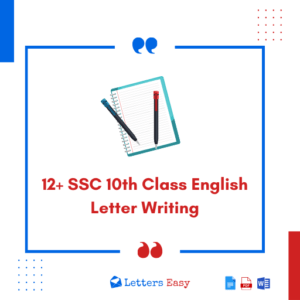
12+ SSC 10th Class English Letter Writing Format, Tips, Examples
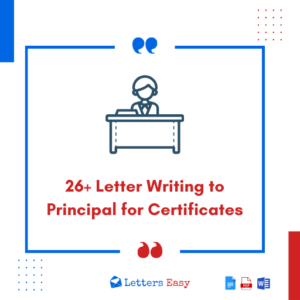
26+ Letter Writing to Principal for Certificates – Format & Samples

20+ Letter Writing in English for Class 6 – Examples, Tips, Topics

10+ Samples for Write a Letter to your Principal for 3 Days Leave

25+ Undertaking Letter Format for Students – Tips, Examples

30+ Sick Leave Letter to Class Teacher from Parents – Templates
Leave a reply cancel reply.
Your email address will not be published. Required fields are marked *
Name *
Email *
Add Comment
Save my name, email, and website in this browser for the next time I comment.
Post Comment
- Essay Editor
Mastering the Art of Essay Writing: How to Write an Essay

Struggling with how to write an essay ? Before you begin writing, it's crucial to brainstorm and organize your thoughts. This guide will cover everything you need to know, from generating ideas to polishing your final draft. Let’s break down the essay writing process into simple, manageable steps that anyone can follow.
Key Takeaways
- A successful essay involves preparation, writing, and revisions with a clear understanding of your message and audience.
- The introduction should hook the reader, present the thesis statement, and give an outline of the essay’s main points.
- Effective body paragraphs focus on a single idea, using evidence and analysis to support the thesis, while revisions and proofreading enhance clarity and correctness.
- It is important to recognize that each essay assignment can differ in requirements, and understanding these differences is crucial for success.
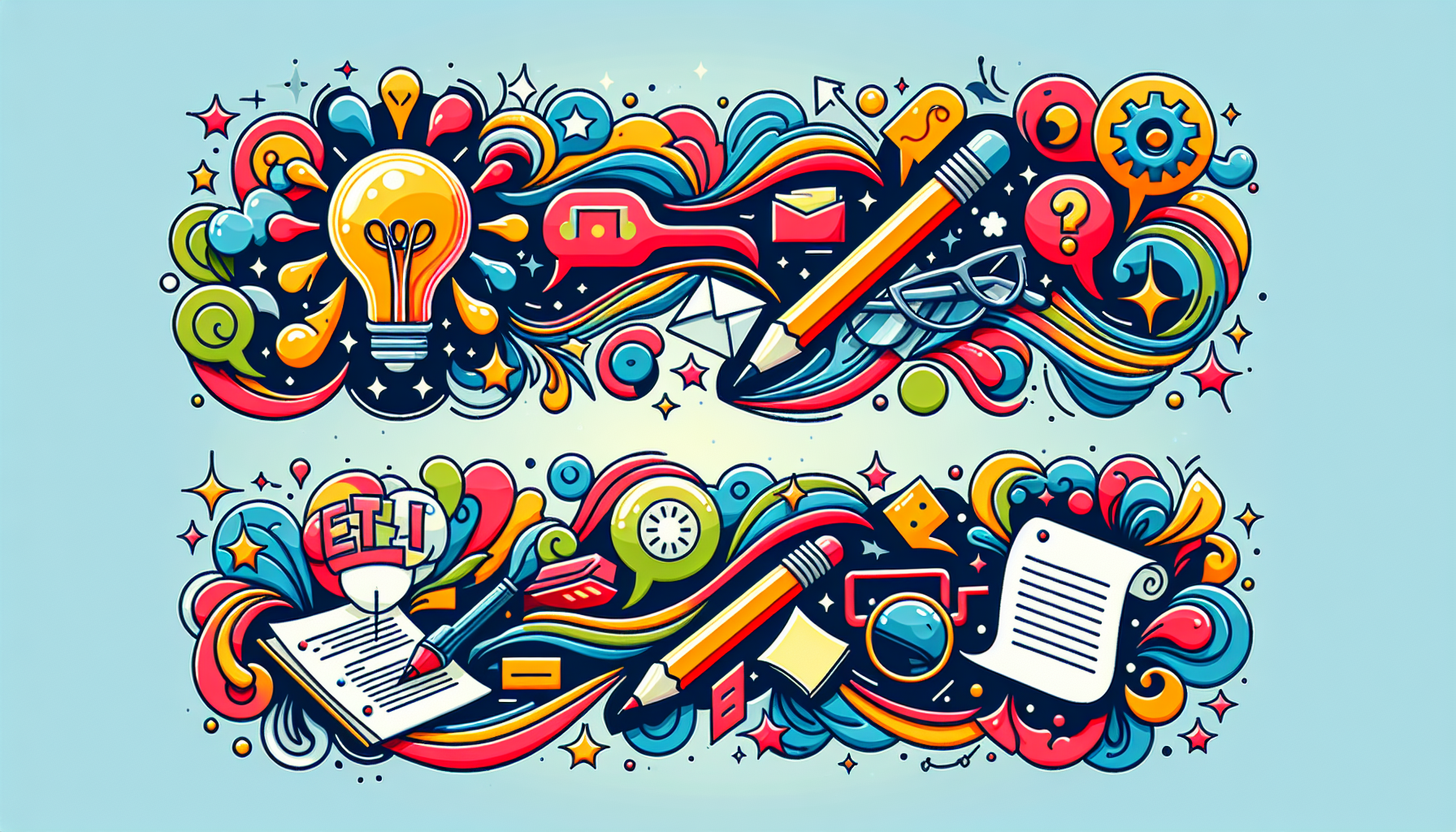
The essay writing process is an art that combines the author’s personal perspective on a topic with various styles, from scholarly to whimsical. As a brief form of expression, essays aim to clarify, debate, describe or recount stories. This craft transcends simple creativity. It requires understanding specific rules and structures.
To produce a compelling essay, one must generate ideas through brainstorming and cultivate a sharp grasp of both the intended message and its presentation. Preparation fosters coherence in argumentation, organization of thoughts, and substantiation—all crucial elements in proficient essay writing. The primary phases encompass preparation work before penning down words followed by revisions after drafting the piece. It is essential to have a clear idea of the essay's structure and content before you start writing, as this preparation can significantly impact the quality of your work.
Acknowledging who will read your work significantly shapes its tone and vocabulary choices. Customizing your material for reader engagement can enhance connection with them substantially. Crafting essays necessitates merging imaginative flair with established norms — perfecting this skill requires consistent practice coupled with unwavering commitment to excellence in writing pursuits.
Introduction
Your essay’s opening paragraph serves as the initial chance to engage your reader and establish the backdrop for your discussion. A compelling introduction can frequently feature a thesis statement that taps into the readers’ interests or concerns, creating immediate relevance. Opening sentences that either pose an intriguing question or offer a captivating quote greatly increase the probability of retaining reader interest.
To capture attention, it’s crucial for an introductory passage to clearly delineate the primary subject matter while also offering up your thesis statement—a concise summary of your essay’s overarching argument. This well-crafted preamble not only prepares readers for what is to follow in subsequent paragraphs, but acts as a comprehensive guide through the narrative journey you’ve constructed, ensuring they remain hooked from beginning to end.
Understanding the Essay Writing Process

Understanding the essay writing process is essential for creating an organized and clear essay. This process encompasses three principal phases: planning, actual writing, and editing. In the initial planning phase, brainstorming sessions are instrumental in generating a range of potential topics to explore. This crucial phase lays the groundwork for focused thinking prior to commencing your written piece. Understanding different formats is essential for successful writing essays.
During the actual drafting phase of essay writing, you embark on composing your essay using both ideas and structure sketched out in your plan. It’s important at this juncture to have a firm grasp of what you intend to communicate and how you wish to do so, with considerations made regarding who will be reading it as this shapes the overall tone and choice of language within your work.
Finally comes revising—the stage where critical enhancements are made that sharpen both clarity and organization within the text. Effective revision necessitates proper time allocation allowing insights into one’s level of understanding and insightfulness about their subject matter. The aim here is refinement—improving content through additions or deletions—and meticulous reorganization aimed at delivering clearer information thus rendering it more impactful for readers.
Knowing Your Audience and Purpose
When embarking on the essay writing journey, one of the foundational steps is to understand your audience and purpose. Knowing who will read your essay and why you are writing it can significantly influence how you present your ideas.
Choosing a Compelling Topic
The initial phase of the essay writing process involves selecting an engaging subject matter. The choice for an essay topic is often influenced by one’s own passions, which can make both research and composition more gratifying and fruitful.
Posing the chosen topic in the form of a research question can sharpen focus throughout the writing journey and maintain direction within your work. A compelling subject not only captures reader interest but also adheres to predetermined assignment criteria, laying down a solid foundation for crafting a standout essay.
Crafting a Strong Thesis Statement
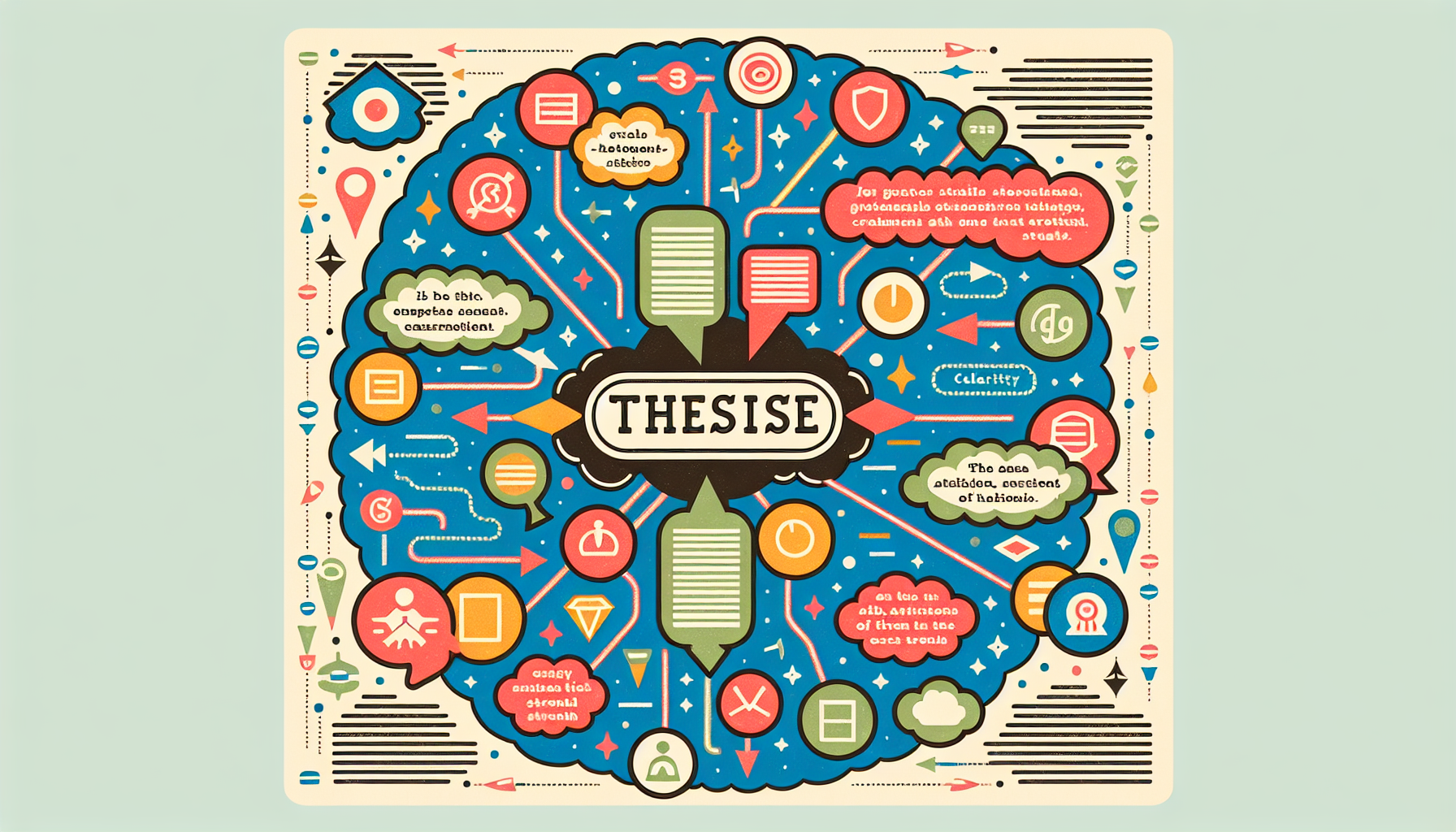
In the opening paragraph of an essay , the thesis statement is essential as it encapsulates the essay’s primary argument and sets its tone. The essence of whether your essay intends to inform or convince should be mirrored in a precise and concrete thesis that communicates your main stance.
This key element usually resides at the conclusion of your introduction paragraph, giving readers immediate insight into what to expect from your composition. It serves as a compass for both writer and reader, ensuring that all parts of the text are aligned with central contentions. As you draft and refine your work, modifying this critical sentence may become necessary to ensure coherence between evolving ideas within your writing.
Structuring Your Essay
Structuring your essay is essential for presenting your ideas logically and coherently. Typically, an essay includes an introduction, body paragraphs, and a conclusion. This format ensures your essay is well-organized and easy to follow.
In the introduction, you should present the topic, thesis statement, and any other contextual information. In longer essays, providing a brief description of each part at the end of the introduction is beneficial. This helps guide the reader and sets clear expectations.
Good body paragraphs should be organized around one main point, using clear topic sentences and supporting evidence. A five paragraph essay requires logical organization to ensure relevance to the thesis throughout.
The conclusion summarizes the main points and reinforces the thesis without introducing new information.
Writing the Introduction Paragraph
The opening paragraph of your essay serves as a critical opportunity to establish a positive initial impact on the reader. Capturing the reader’s attention can be accomplished with compelling hooks like posing an engaging question, presenting an unexpected truth, or making a striking declaration. It is crucial for the introduction to delineate the subject matter and introduce the thesis statement that encapsulates the central point of your essay.
Ending this introductory section with a concise outline of what will be discussed helps orient readers from the beginning. By meticulously sculpting this part, you lay down firm groundwork for subsequent body paragraphs while securing active interest from your audience.
Developing Effective Body Paragraphs
Paragraphs within the body of a text are essential for demonstrating and supporting the thesis stated in the introduction. They should each center on a principal argument, providing evidence to maintain both lucidity and connectedness.
We will delve into organizing paragraph structure efficiently and how best to present evidence in forthcoming sections.
Organizing Paragraph Structure
Well-organized paragraphs improve clarity and help readers follow the writer’s thoughts more easily. Each paragraph should focus on a single idea, clearly introduced by a topic sentence that relates to the thesis.
Effective paragraphs present relevant evidence and include analysis that connects back to the topic sentence. Transitional phrases enhance coherence, while varied sentence structures and precise language contribute to effective writing.
Presenting Evidence
Within the body paragraphs, support for the central argument should come in the form of data, quotes, or examples that trail the topic sentence. It’s crucial to elucidate how these instances are pertinent to the thesis by adding context, thereby bolstering your argument.
Following an example with a rationale linking it back to your thesis is vital. Utilizing transition words helps in forging coherent links between sentences and maintains a seamless progression of ideas throughout.
Crafting the Conclusion Paragraph
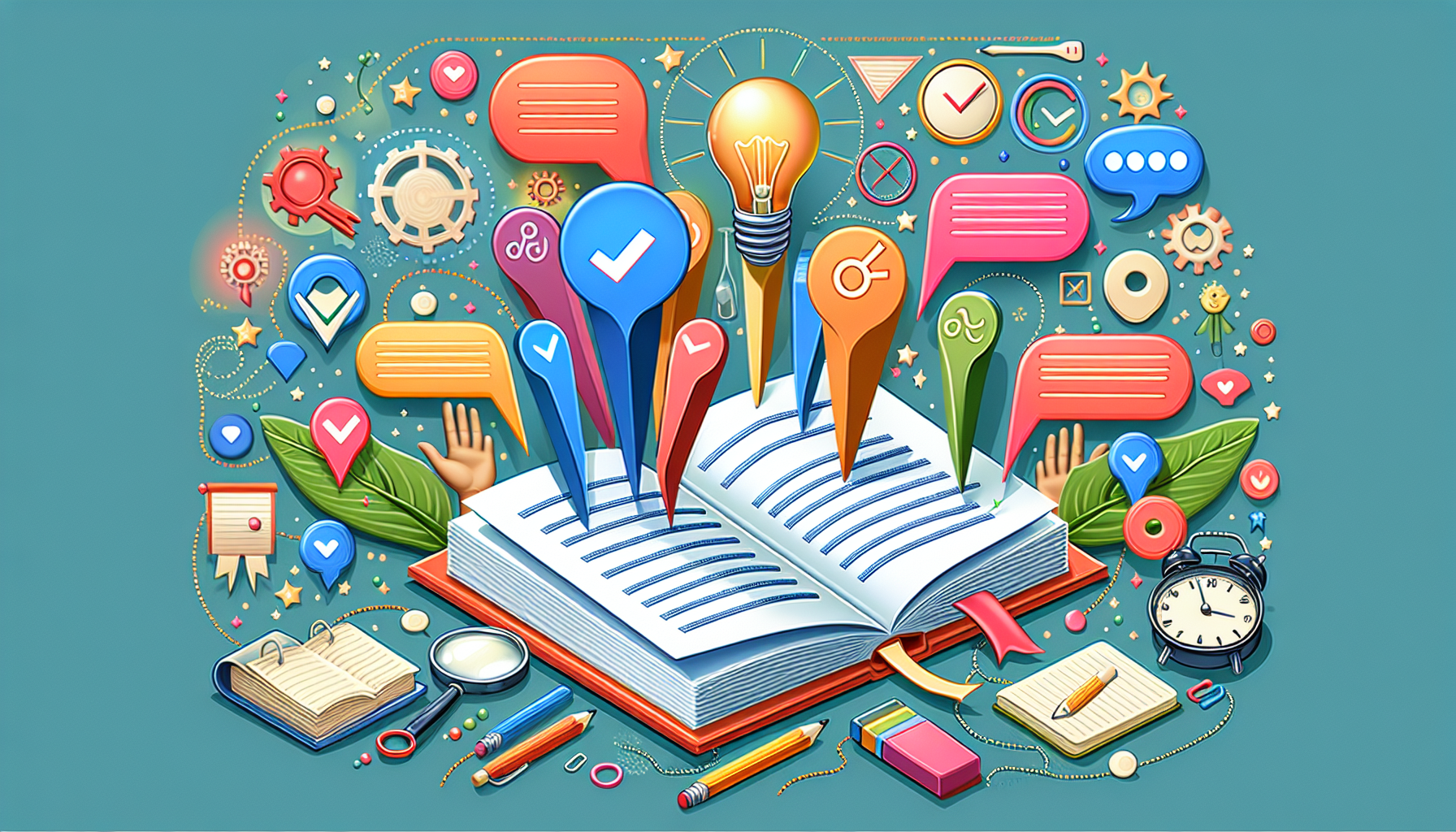
In wrapping up an essay, it is crucial to recapitulate the key points while underscoring the importance of the argument. It’s not merely about summarizing. Rather, one must also impart a sense of finality and larger relevance.
Restating the thesis distinctively serves to refresh the reader’s memory on what constitutes the core point of your discourse. The concluding sentence should offer closure yet stimulate contemplative consideration without explicitly stating phrases such as ‘in conclusion,’ since readers are already aware they have reached the end of your exposition.
Types of Essays and Their Purposes
Essays come in various forms, each serving a unique purpose. Understanding the type of essay you need to write can help you structure your thoughts and arguments more effectively.
Revising and Editing Your Essay
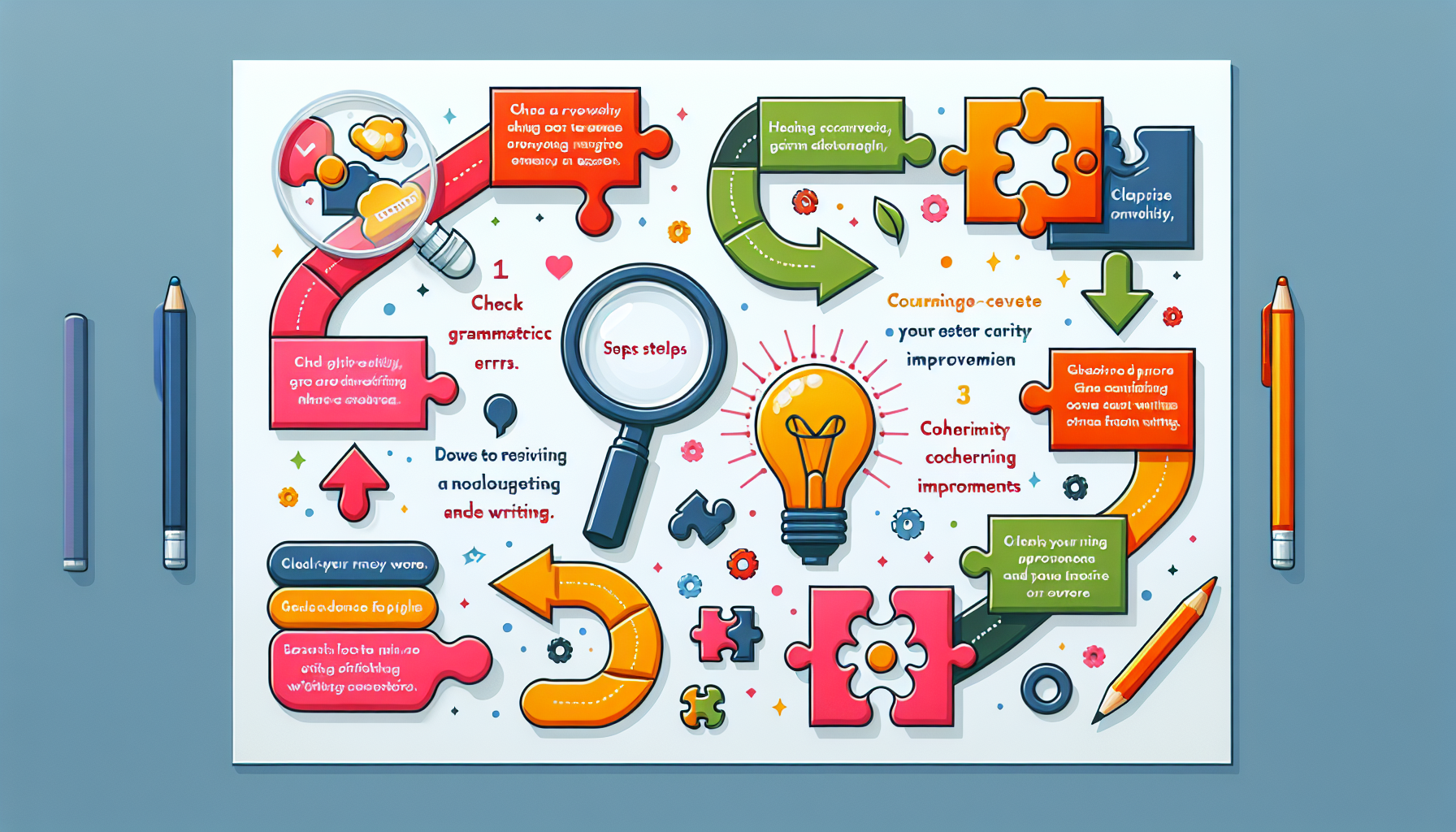
The revision phase is a vital element of the writing process, offering an opportunity to elevate both clarity and cohesion. During this stage, one should reassess the essay’s material with the intent not only to rectify errors but also to enrich its content. Such enhancement may require expansion, reduction or even altering the arrangement of information for improved lucidity and engagement.
Editing serves as a fine-tuning mechanism that sharpens ideas by focusing on grammar, punctuation, and sentence construction to enhance overall writing skills. Input from peers or advisors can be instrumental in pinpointing areas where refinement is needed.
Allocating dedicated time for comprehensive editing and proofreading is essential in achieving a well-crafted final draft that shines with polished precision.
Seeking Feedback and Improvement
Once you’ve completed your first draft, seeking feedback is a crucial step in refining your essay. Constructive feedback can provide new perspectives and highlight areas for improvement.
Proofreading for Grammatical Errors
By concentrating on a single category of mistake while proofreading, you increase precision and diminish the likelihood of overlooking major errors. The process not only corrects grammatical inaccuracies, but also boosts the text’s comprehension.
Utilizing your auditory senses through reading the material out loud can uncover mistakes, as it exposes how the content actually sounds when spoken. Employing these strategies greatly cuts down on grammatical mistakes and enhances the caliber of your essay.
Final Checklist Before Submission
Before handing in your essay, verify that it aligns with all other parts of your application, maintaining uniformity and preventing any mismatch in details. Ascertain the proper submission of supplementary items like portfolios and letters of recommendation.
It’s crucial to adhere strictly to the deadlines set by each educational establishment and be well-informed about their specific submission procedures. Having an editor go over your work can offer additional assurance before you submit it.
To excel in essay writing, it is essential to have a firm grasp of the various steps involved in the writing process. This includes selecting an intriguing topic and forming a robust thesis statement, as well as organizing your thoughts into a coherent structure from the introductory paragraph through to the concluding section. Each component serves an integral function in delivering your concepts with clarity and interest.
Keep in mind that composing essays is an iterative endeavor that necessitates dedication and repetition. Adhering to the strategies provided here will set you on course towards producing captivating compositions that effectively communicate your intended message to your audience.
Frequently Asked Questions
What is the most important part of an essay.
The most important part of an essay is a strong thesis statement, as it clearly outlines your main argument and guides your writing.
Without it, your essay may lack focus and direction.
How can I choose a compelling topic for my essay?
Choosing a compelling essay topic starts with exploring your personal interests and turning them into a clear research question.
This will keep your writing focused and ensure it meets the assignment requirements.
How do I craft a strong thesis statement?
To craft a strong thesis statement, make sure it’s specific and clearly conveys your main argument and position related to your essay’s topic.
This clarity will guide both your writing and your readers.
What are some tips for revising and editing my essay?
To effectively revise and edit your essay, focus on improving content clarity and structure during revision, and refine grammar and punctuation while editing.
Don’t forget to seek peer feedback for valuable insights!
What techniques can I use for effective proofreading?
For effective proofreading, try reading aloud, concentrating on one type of mistake at a time, and breaking your text into smaller sections.
These techniques can really help you catch errors and enhance readability.
Related articles
Best places to do homework that will create a perfect study heaven for you.
Are you wondering, ‘Where can I go to do homework?’ Finding the ideal spot for studying can significantly affect your productivity and overall study experience. Whether you're a student seeking solace or someone looking for a change of scenery, selecting the right environment is key to maximizing your efficiency and focus. In this guide, we’ll discover various places to do homework that can transform your study routine into a more engaging and effective experience. The Importance of Having a C ...
Top 5 Creative Book Report Ideas That Guarantee Success in Class
Assigned reading helps students develop their critical analysis skill, and book reports test their progress. But it is not enough to simply analyze a literary work — you also need to express your creativity while presenting book report ideas. In this article, you will learn the definition of a literary report, its purpose, and five alternative book report ideas to show off your creativity in class. What is a book (literary) report? A book report is an overall summary and personal assessment o ...
Discussion Posts: Definition, Overview, Writing Tips
Discussions are an important part of academic studies. They foster collaboration, raise student engagement, and help to better process new information. A common way to involve students in critical debate is through discussion posts. In this article, you will learn what a discussion post is and how to write it. Discussion post and open forum definition A discussion post is a written reply typically used in online forums – websites that encourage users to engage in a debate over various subject ...
How to Write a Table of Contents for Research Paper: A Complete Guide
After hundreds of hours of non-stop working, the research essay is finished! Unfortunately, it is not the time to celebrate. That’s when you must get down to one of the least pleasant things in professional college or high school writing – a table of contents. The following article will define table of contents, discuss its purpose, and provide guidance on how to make a table of contents for a research paper. What is a research paper table of contents? Academic essays can be from 2–3 to hundr ...
Top 10 Excuses for Not Doing Homework: How to Trick Your Teacher in 2024
Whether it’s because you’re buried in other commitments or just had a seriously off day, finding credible excuses for not doing homework can save your day. Here's a brief look at the top 10 homework excuses, with tips on making them sound as true as possible. Just remember, use these wisely and try to stay on top of your assignments! 1. “My computer crashed right before I finished” In today’s digital world, technology problems are a plausible justification. Claiming that your laptop glitched ...
How to Write a History Essay: A Guideline for Non-Historians
History is a difficult discipline, no one can argue with that. It is especially challenging to write a history essay when you have zero historian bone in your body. That’s why today our goal is to teach you how to write a history essay. What is history essay? A historical paper is a classic instance of a scholarly work that seeks to examine and give answers to questions about long-gone factual incidents and their consequences. Unlike a simple narrative or description, a history paper demands ...
Top Proven Tips on How to Make Homework Fun
Everyone agrees that school would be much cooler if there were no homework. Alas, this is an impossible wish. Luckily, no one stops us from making it fun! In this article, you will find some awesome tips on how to make homework fun. 1. Create a comfortable study space Having a separate place where you can study is very important. Sure, you might think sitting on a couch with a laptop in your lap is as fun as it can get, but in reality, it may hinder your progress. Your brain knows that the co ...
Why Homework Is Good for Students: 20 No-Nonsense Reasons
Is homework beneficial in education? It has long been a cornerstone, often sparking debates about its value. Some argue it creates unnecessary stress, while others assert it’s essential for reinforcing in-class learning. Why is homework important? The reality is, that homework is vital for students' personal and academic growth. It not only improves their grasp of the material but also develops crucial skills that extend well beyond the classroom. This review explores 20 reasons why homework is ...
Purdue Online Writing Lab Purdue OWL® College of Liberal Arts
Sample Letters

Welcome to the Purdue OWL
This page is brought to you by the OWL at Purdue University. When printing this page, you must include the entire legal notice.
Copyright ©1995-2018 by The Writing Lab & The OWL at Purdue and Purdue University. All rights reserved. This material may not be published, reproduced, broadcast, rewritten, or redistributed without permission. Use of this site constitutes acceptance of our terms and conditions of fair use.
If you are using letterhead, do not include the sender's address at the top of the letter; instead, begin with the date.
Block Format
123 Winner's Road New Employee Town, PA 12345
March 16, 2001
Ernie English 1234 Writing Lab Lane Write City, IN 12345
Dear Mr. English:
The first paragraph of a typical business letter is used to state the main point of the letter. Begin with a friendly opening, then quickly transition into the purpose of your letter. Use a couple of sentences to explain the purpose, but do not go in to detail until the next paragraph.
Beginning with the second paragraph, state the supporting details to justify your purpose. These may take the form of background information, statistics or first-hand accounts. A few short paragraphs within the body of the letter should be enough to support your reasoning.
Finally, in the closing paragraph, briefly restate your purpose and why it is important. If the purpose of your letter is employment related, consider ending your letter with your contact information. However, if the purpose is informational, think about closing with gratitude for the reader's time.
Lucy Letter
Modified Block Format
(Tab to center, begin typing) 123 Winner's Road New Employee Town, PA 12345
(Tab to center, begin typing) Sincerely,
(Tab to center, begin typing) Lucy Letter
Semi-Block Format
(Indent) The first paragraph of a typical business letter is used to state the main point of the letter. Begin with a friendly opening, then quickly transition into the purpose of your letter. Use a couple of sentences to explain the purpose, but do not go in to detail until the next paragraph.
(Indent) Beginning with the second paragraph, state the supporting details to justify your purpose. These may take the form of background information, statistics or first-hand accounts. A few short paragraphs within the body of the letter should be enough to support your reasoning.
(Indent) Finally, in the closing paragraph, briefly restate your purpose and why it is important. If the purpose of your letter is employment related, consider ending your letter with your contact information. However, if the purpose is informational, think about closing with gratitude for the reader's time.

How to write a letter
HOW TO WRITE A LETTER: A GUIDE FOR TEACHERS AND STUDENTS

In this age of digital communication, writing letters is becoming something of a lost art. Emails and text messages can be sent instantly and for a fraction of the cost good old-fashioned snail mail can offer.
So, why bother teaching letter-writing at all? Well, though electronic ‘letters’ are often freer in formatting and language than physical letters, we can also apply letter-writing rules to electronic media. However, physical letters do offer some distinct benefits of their own too.
A WELL-WRITTEN LETTER CAN CHANGE THE WORLD.
Whilst we pride ourselves here on how to write a great essay, information report, or another text type that is primarily used in an educational setting, the ability to craft a powerful letter or email has literally changed people’s lives, altered the course of history and been the difference between life and death in some cases.
It can be the one opportunity to remove all the noise and confusion on any subject area and honestly tell someone how you feel straight from the heart. Pen to paper.
For whatever reason, a thousand emails, tweets, and likes will never have the same impact as a well-crafted handwritten letter. Its very creation and existence show your reader how passionate and genuine about what it contains.
Letters fall under the transactional writing category; if you want to know more about transactional texts, be sure to check out our in-depth guide here.

COMPLETE LETTER WRITING UNIT FOR STUDENTS
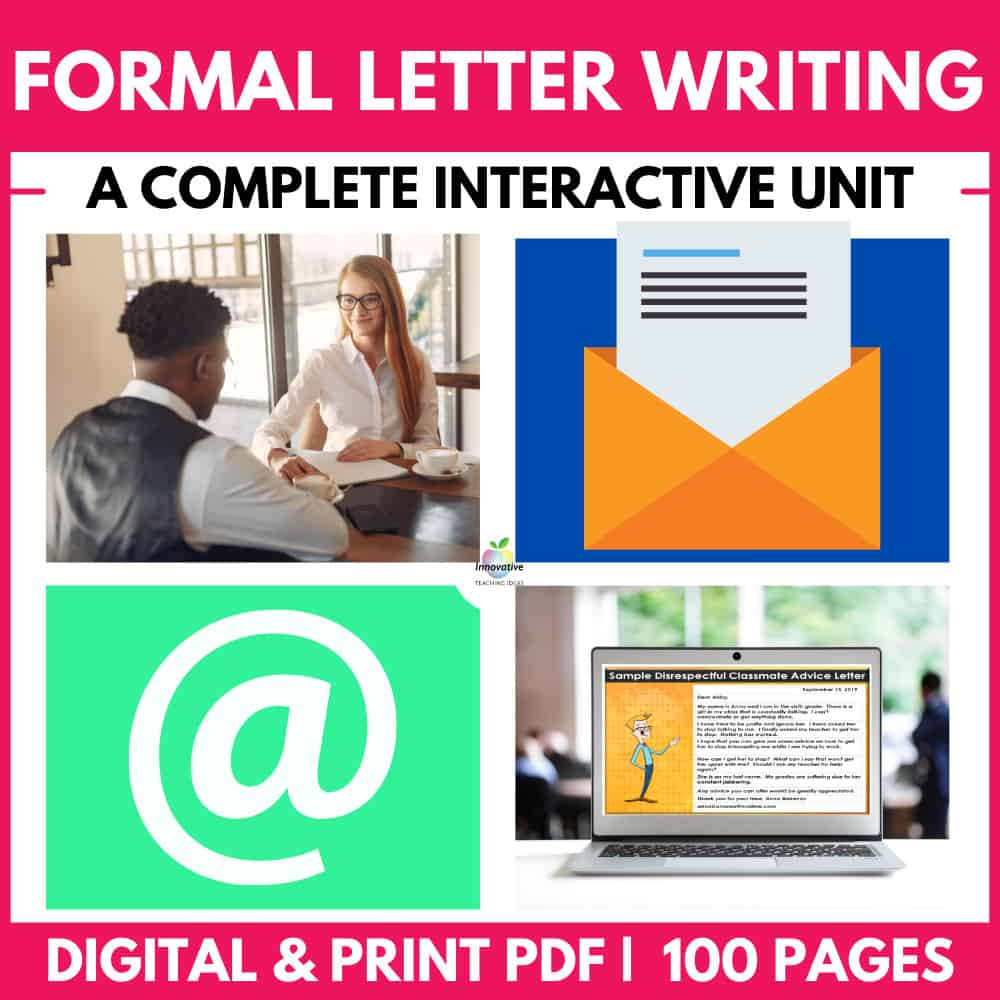
Over 100 PAGES of engaging RESOURCES , various letter SAMPLES , LESSON PLANS and INTERACTIVE DIGITAL RESOURCES to teach your students how to write amazing LETTERS and EMAILS .
Teach this life skill with confidence through this excellent ALL-IN-ONE RESOURCE . No preparation is required.
3 REASONS TO TEACH LETTER WRITING
1. the personal touch: .

Those of us who grew up in an age before the internet got going will remember the excitement of waiting for and receiving a letter. Many of us will have had childhood pen pals we never met or received love letters from our teenage sweethearts. Maybe some treasured letters are still securely stored in a bedside drawer.
There is something extremely personal and intimate about the letter that email cannot capture. Letters are physical, and their increasing rarity makes them seem even more intimate today.
In this day and age, receiving a personally written letter is something a unicorn in communication terms. Students who know how to produce a well-crafted letter can use it to their advantage. For example, any business hiring manager will undoubtedly be numbed by the constant torrent of emails flooding their inbox.
That mailed resume accompanied by a handwritten letter that waits for them on their desk in the morning will surely stand out and secure an attentive read. The letter, in its various forms, is guaranteed to stand out and make an impact in an age where the vast majority of communication is digital.
3. Handwriting

Just as letter writing has declined in popularity, so too has the emphasis on well-developed handwriting skills. You can, if you wish, take the opportunity here to have the students work on their handwriting skills.
While students may protest that they can accomplish the task much quicker by word-processing, another benefit of handwriting a letter is that the speed becomes almost meditative. This allows students to focus carefully on their grammar and punctuation without always resorting to the crutch of spell-checkers and grammar correction software.
FORMAL AND INFORMAL LETTER WRITING: WHAT’S THE DIFFERENCE?
The table below outlines whether your letter should be written formally or informally, with some suggested prompts . Whilst there are many similarities, a formal letter should always be considered as a document with a real purpose and ramifications.
FORMAL LETTER FEATURES
USED FOR PROFESSIONAL COMMUNICATION THESE DOCUMENTS FOLLOW A PRESCRIBED FORMAT. THEY ARE WRITTEN IN A PASSIVE VOICE FOR A SPECIFIC PURPOSE AND IN MANY CASES ARE LEGALLY BINDING. SOME EXAMPLES ARE.
INVITATION Make someone feel special about an upcoming event.
APPLICATION Write a professional letter of application for a job or group you wish to join.
REFEREE / REFERENCE Vouch for another’s skills, personality or credibility.
ACCEPTANCE & REJECTION Approve or deny an applicant in a professional manner.
MAKE AN OFFER Make a formal and binding offer in writing.
EXIT / RESIGNATION Formally leave or step down in a professional and dignified manner.
INFORMAL LETTER FEATURES
USED FOR PERSONAL COMMUNICATION THESE LETTERS HAVE NO PRESCRIBED FORMAT AND ARE WRITTEN IN AN ACTIVE VOICE.
THANK YOU Let someone know you appreciate their efforts.
CONGRATULATIONS Acknowledge someone’s achievements in life.
GRIEVANCE / LOSS Acknowledge someones personal loss or suffering and let them know you care.
FRIENDSHIP & LOVE Tell someone how special they are to you and why?
LETTER TO THE EDITOR / MAYOR ETC. Let someone know how their actions and adversely affect you and others.
LETTER TO SELF Give your older or younger self some words of advice and wisdom.
INFORMATIONAL UPDATE Write a letter back home telling them what you have been up to.
HOW TO WRITE FORMAL LETTERS
The writing process begins with planning.
As with all genres of writing, the process of formal letter writing should start with planning. This should involve sketching a brief outline from which to work rather than a comprehensive detailing of minutiae. The plan should include:
- Note addresses, names etc. – who are you writing to?
- Record the purpose of the letter – what do you want to say?
- List points to be made (each will form a paragraph) – how will you say it?
- State action point – what do you want the reader to do?
Formal letters can be written for a wide range of purposes and may come in various shapes, including a letter of complaint, a cover letter accompanying a job application, a letter of invitation, a reference letter, or a proposal letter – to name a few. Though each will adhere to its own rules of formatting and tone when writing formal letters, students should avoid using slang or contractions.
Language should be straightforward and polite. Encourage students to avoid bursts of purple prose in favor of direct, functional language. Usually, a formal letter will be written to achieve a particular end and should be written with that end foremost in mind. Students should avoid meanderings and stay firmly focused on the task at hand.
TIPS FOR WRITING GREAT FORMAL LETTERS

- The writer’s address should be in the top right-hand corner.
- The date should be written below the writer’s address
- The recipient’s name and address are below that on the left-hand side
- Use the correct opening (Dear Sir / Madam, Dear Mrs Ferguson, etc.)
- Use Standard English
- The opening sentence should explain the purpose of the letter
- Each paragraph should make a single specific point
- Use an appropriate formal tone and register in the wording of the letter
- Avoid contractions, slang, and abbreviations
- The concluding ‘action point’ paragraph states what you want the recipient to do
- The formal ending, such as Yours Sincerely or Yours Faithfully
A Note on Salutations
If the student knows the intended recipient’s name, start with Dear Mr. / Mrs Surname and end with Yours Sincerely. If they don’t know the recipient’s name, start with Dear Sir / Madam and end with Yours Faithfully.
Use of Rhetorical Devices
As mentioned, formal letter writing focuses on attempting to convince someone to take some course of action or other. To do this, it is helpful to employ some rhetorical devices to make the writing more persuasive . Some useful techniques to encourage your students to employ include:
Direct Address: Using the pronoun ‘you’ in a formal letter makes the reader feel that you are speaking directly to them. This helps to engage the reader and encourage them to continue reading the letter.

Emotive Language: Where students are trying to convince the reader to take a course of action, the use of emotive language can often be a powerful tool. Students can use either positive or negative colored words to create the desired response in the reader.
Facts and Figures: Another way to persuade and convince is to employ facts and figures to support the points made in the letter.
FORMAL LETTER STUDENT EXAMPLES

How to write an informal letter
Common features of informal letters:.
There are far fewer rules to follow when writing an informal letter, but there are still some practical guidelines to follow that will prove helpful for students engaged in writing informally.
As with any piece of writing, it is important to consider who the audience is and the reason for writing in the first place. In particular, this will help decide the tone and the language register. The more intimate the relationship, the more informal the language can be.
Though the letter will be informal, it will still have a purpose. Information should still be organized into paragraphs, as would be done with a formal, more ‘official’ letter. Students sometimes struggle with this aspect, as they often conflate ‘informal’ with ‘disorganized.’ Making them plan their informal letter before writing can help ensure it is sufficiently organized.
HOW TO START AN INFORMAL LETTER
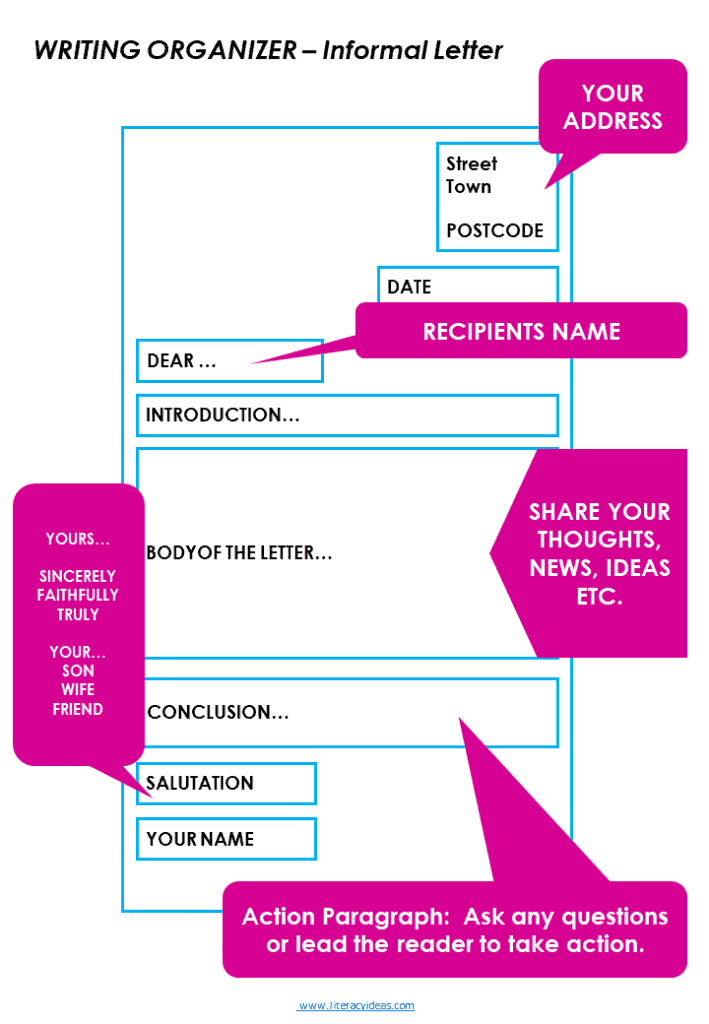
Informal letters will start with a greeting appropriate to how close the relationship is. For acquaintances, this may be ‘Dear Tom,’ (using the first name instead of the surname) to a very informal ‘Hi Jane,’. Don’t forget the comma after the name!
After the greeting, a general opening sentence should follow. Usually, this will be something like a ‘How are you?’ or a ‘How have you been?’. If the recipient is married or has kids, you may wish to ask how their spouse or children are.
Next, students should state the reason for writing. The language should be open and friendly in tone and, in contrast to the formal letter, colloquial language, idiomatic expressions, and contractions are perfectly okay and even desirable.
Just as the opening salutation to an informal letter is much more relaxed, so too will the closing salutation. There are many possibilities for the students to choose here, and their decision will depend on who they are writing to and their personal preferences. Some examples of possible closings include ‘Love’, ‘Best regards’, ‘All the best’, and ‘Thanks’.

INFORMAL LETTER STUDENT EXAMPLES

Teaching Resources
Use our resources and tools to improve your student’s writing skills through proven teaching strategies.
PRACTICE LETTER WRITING WITH THESE ACTIVITIES FOR STUDENTS
The most effective way for students to internalize all the features of letter writing, formal or informal, is to gain experience by writing various letters for differing purposes. The following activities offer some suggestions for students to get practising today:
1. FICTION AS A SPRINGBOARD
Have students write as if they were a character from a piece of fiction you have been reading in class. Choosing a dramatic point in the plot , ask students to imagine they are one of the characters writing a letter to another character in the story. This writer may be either formal or informal, depending on the scenario presented. This will give students realistic letter-writing practice while also getting them to engage closely with the text and respond imaginatively to its themes.
2. THE AGONY AUNT
Either offer a range of possible life predicaments or cut out the questions from the ‘agony aunt’ page of a local newspaper. Students must write back offering advice in response to the predicaments expressed in the question or predicament. The response should be written in full letter format. This activity also lends itself to several variations. The response may be written to a close friend, for example, or written from the perspective of a professional agony aunt employing a more formal tone and presentation.
3. A LETTER OF COMPLAINT
Have students think of their favorite candy bar or clothing item. Encourage them to imagine they have bought this product lately and found it to be substandard. Students must write a formal letter of complaint to the manufacturer outlining their complaint and recommending a course of action to satisfactorily resolve that complaint. They must use all the features of a formal letter as outlined above.

HOW TO MAKE YOUR HANDWRITTEN LETTERS LOOK OLD AND AUTHENTIC.
- Write in pencil or a calligraphy pen,
- screw them up tightly and carefully unfold and flatten.
- Lightly dab coffee stains over the paper to make it look aged.
- Carefully singe or burn the edges of your paper.
- Add some sepia-filtered photos for effect.
SIGNING-OFF
As students become more confident in their understanding of letter-writing formats, encourage them to exchange letters with each other for peer assessment. You may wish to provide them with a checklist of features to look for while reading over their partner’s work.
Letter-writing can also be a great way to partner up with schools overseas; often, children studying English as a second language will be delighted to receive letters from (and write to) students in English-speaking countries. And though email increasingly encroaches on the traditional territory of the letter, many of the skills garnered in the practice of letter writing are transferable to the modern manifestation. There is ample opportunity here to link letter-writing learning with approaches to writing emails too.
Letter-writing can provide a focus for a wide range of learning objectives while also teaching students valuable practical skills that will serve them well beyond their school years, both in their personal and work lives. And who knows, perhaps in years to come, one of the letters your student writes in your class may become a treasured keepsake in someone’s bedside drawer.
LETTER WRITING GRAPHIC ORGANIZERS (TEMPLATES)
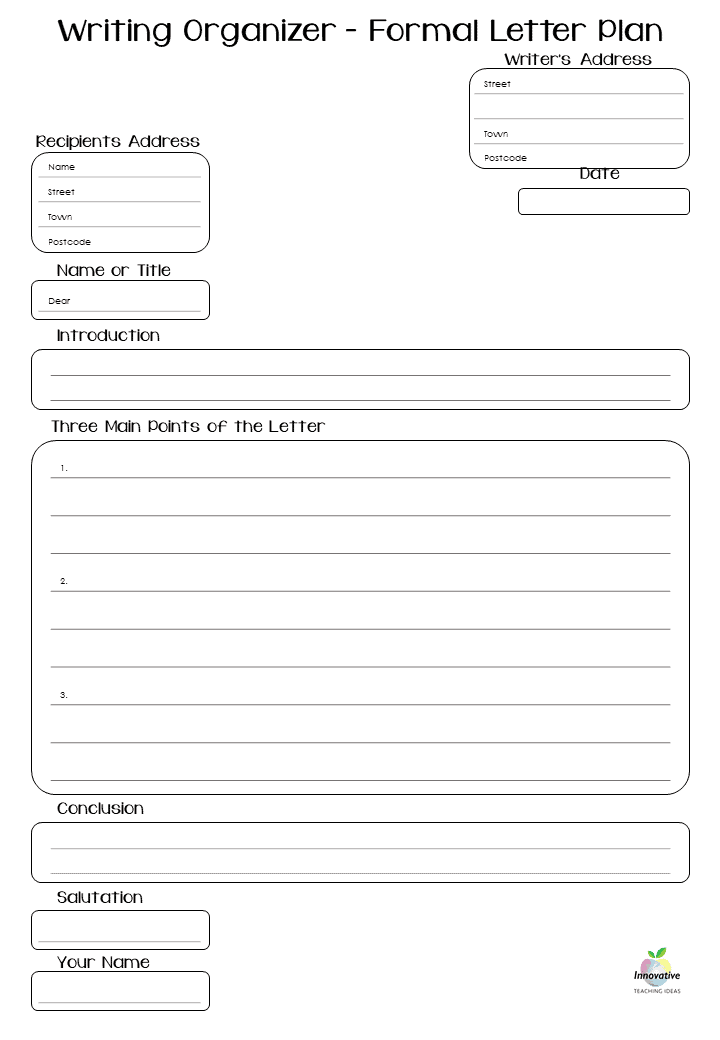
WRITING CHECKLIST & RUBRIC BUNDLE FOR ALL TEXT TYPES

⭐⭐⭐⭐⭐ (92 Reviews)
HOW TO WRITE A FORMAL LETTER TUTORIAL VIDEO
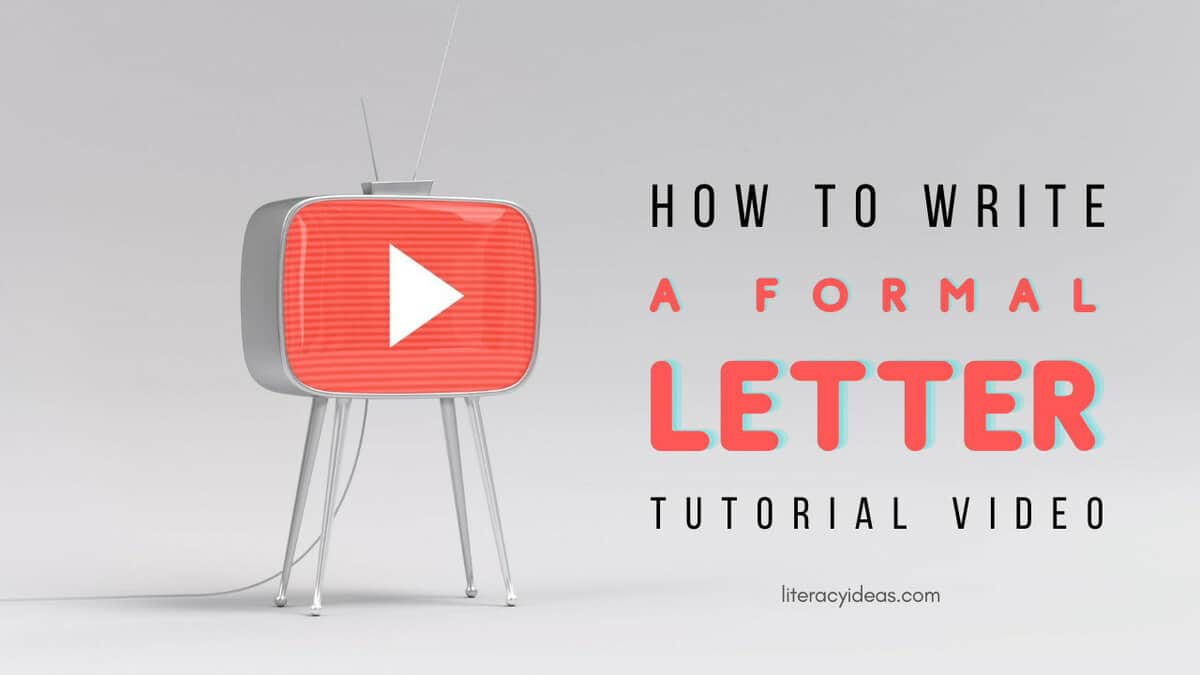
OTHER GREAT ARTICLES RELATED TO LETTER WRITING
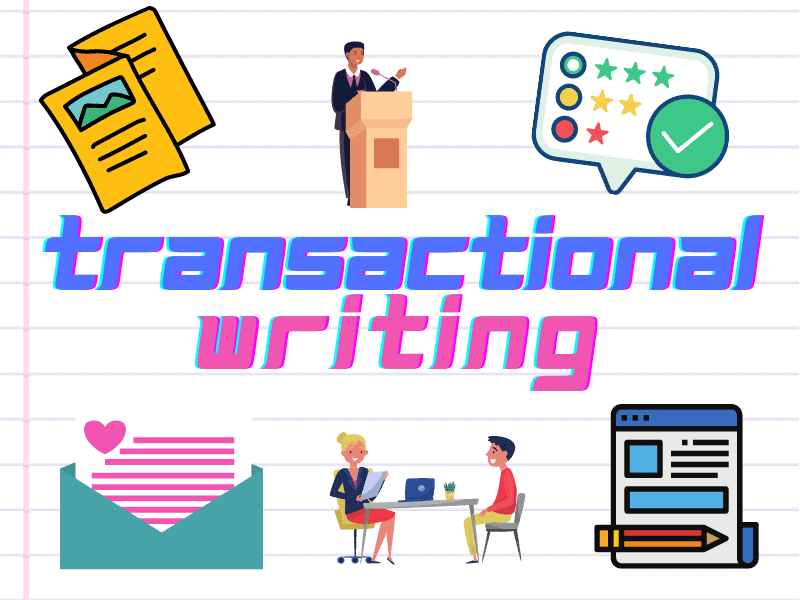
Transactional Writing

Personal Narrative Writing Guide

How to Write a Recount Text (And Improve your Writing Skills)
Content for this page has been written by Shane Mac Donnchaidh. A former principal of an international school and university English lecturer with 15 years of teaching and administration experience. Editing and support content has been provided by the literacyideas team.
Tips for Reading an Assignment Prompt
Asking analytical questions, introductions, what do introductions across the disciplines have in common, anatomy of a body paragraph, transitions, tips for organizing your essay, counterargument, conclusions.
Tips for Writing an Effective Application Essay
Writing an essay for college admission gives you a chance to use your authentic voice and show your personality. It's an excellent opportunity to personalize your application beyond your academic credentials, and a well-written essay can have a positive influence come decision time.
Want to know how to draft an essay for your college application ? Here are some tips to keep in mind when writing.
Tips for Essay Writing
A typical college application essay, also known as a personal statement, is 400-600 words. Although that may seem short, writing about yourself can be challenging. It's not something you want to rush or put off at the last moment. Think of it as a critical piece of the application process. Follow these tips to write an impactful essay that can work in your favor.
1. Start Early.
Few people write well under pressure. Try to complete your first draft a few weeks before you have to turn it in. Many advisers recommend starting as early as the summer before your senior year in high school. That way, you have ample time to think about the prompt and craft the best personal statement possible.
You don't have to work on your essay every day, but you'll want to give yourself time to revise and edit. You may discover that you want to change your topic or think of a better way to frame it. Either way, the sooner you start, the better.
2. Understand the Prompt and Instructions.
Before you begin the writing process, take time to understand what the college wants from you. The worst thing you can do is skim through the instructions and submit a piece that doesn't even fit the bare minimum requirements or address the essay topic. Look at the prompt, consider the required word count, and note any unique details each school wants.
3. Create a Strong Opener.
Students seeking help for their application essays often have trouble getting things started. It's a challenging writing process. Finding the right words to start can be the hardest part.
Spending more time working on your opener is always a good idea. The opening sentence sets the stage for the rest of your piece. The introductory paragraph is what piques the interest of the reader, and it can immediately set your essay apart from the others.
4. Stay on Topic.
One of the most important things to remember is to keep to the essay topic. If you're applying to 10 or more colleges, it's easy to veer off course with so many application essays.
A common mistake many students make is trying to fit previously written essays into the mold of another college's requirements. This seems like a time-saving way to avoid writing new pieces entirely, but it often backfires. The result is usually a final piece that's generic, unfocused, or confusing. Always write a new essay for every application, no matter how long it takes.
5. Think About Your Response.
Don't try to guess what the admissions officials want to read. Your essay will be easier to write─and more exciting to read─if you’re genuinely enthusiastic about your subject. Here’s an example: If all your friends are writing application essays about covid-19, it may be a good idea to avoid that topic, unless during the pandemic you had a vivid, life-changing experience you're burning to share. Whatever topic you choose, avoid canned responses. Be creative.
6. Focus on You.
Essay prompts typically give you plenty of latitude, but panel members expect you to focus on a subject that is personal (although not overly intimate) and particular to you. Admissions counselors say the best essays help them learn something about the candidate that they would never know from reading the rest of the application.
7. Stay True to Your Voice.
Use your usual vocabulary. Avoid fancy language you wouldn't use in real life. Imagine yourself reading this essay aloud to a classroom full of people who have never met you. Keep a confident tone. Be wary of words and phrases that undercut that tone.
8. Be Specific and Factual.
Capitalize on real-life experiences. Your essay may give you the time and space to explain why a particular achievement meant so much to you. But resist the urge to exaggerate and embellish. Admissions counselors read thousands of essays each year. They can easily spot a fake.
9. Edit and Proofread.
When you finish the final draft, run it through the spell checker on your computer. Then don’t read your essay for a few days. You'll be more apt to spot typos and awkward grammar when you reread it. After that, ask a teacher, parent, or college student (preferably an English or communications major) to give it a quick read. While you're at it, double-check your word count.
Writing essays for college admission can be daunting, but it doesn't have to be. A well-crafted essay could be the deciding factor─in your favor. Keep these tips in mind, and you'll have no problem creating memorable pieces for every application.
What is the format of a college application essay?
Generally, essays for college admission follow a simple format that includes an opening paragraph, a lengthier body section, and a closing paragraph. You don't need to include a title, which will only take up extra space. Keep in mind that the exact format can vary from one college application to the next. Read the instructions and prompt for more guidance.
Most online applications will include a text box for your essay. If you're attaching it as a document, however, be sure to use a standard, 12-point font and use 1.5-spaced or double-spaced lines, unless the application specifies different font and spacing.
How do you start an essay?
The goal here is to use an attention grabber. Think of it as a way to reel the reader in and interest an admissions officer in what you have to say. There's no trick on how to start a college application essay. The best way you can approach this task is to flex your creative muscles and think outside the box.
You can start with openers such as relevant quotes, exciting anecdotes, or questions. Either way, the first sentence should be unique and intrigue the reader.
What should an essay include?
Every application essay you write should include details about yourself and past experiences. It's another opportunity to make yourself look like a fantastic applicant. Leverage your experiences. Tell a riveting story that fulfills the prompt.
What shouldn’t be included in an essay?
When writing a college application essay, it's usually best to avoid overly personal details and controversial topics. Although these topics might make for an intriguing essay, they can be tricky to express well. If you’re unsure if a topic is appropriate for your essay, check with your school counselor. An essay for college admission shouldn't include a list of achievements or academic accolades either. Your essay isn’t meant to be a rehashing of information the admissions panel can find elsewhere in your application.
How can you make your essay personal and interesting?
The best way to make your essay interesting is to write about something genuinely important to you. That could be an experience that changed your life or a valuable lesson that had an enormous impact on you. Whatever the case, speak from the heart, and be honest.
Is it OK to discuss mental health in an essay?
Mental health struggles can create challenges you must overcome during your education and could be an opportunity for you to show how you’ve handled challenges and overcome obstacles. If you’re considering writing your essay for college admission on this topic, consider talking to your school counselor or with an English teacher on how to frame the essay.
Find the right college for you
Related articles.
Free All Office Suite with PDF Editor
Edit Word, Excel, and PPT for FREE.
Read, edit, and convert PDFs with the powerful PDF toolkit.
Microsoft-like interface, easy to use.
Windows • MacOS • Linux • iOS • Android

- Articles of Word
How to Address a Letter - Steps with Examples
Have you ever faced a situation where you need to write a letter—whether for a job application, a complaint, or a resignation—but find yourself staring blankly at the screen, unsure how to begin? If so, you’ll find this article invaluable. Here, I’ll guide you on how to address a letter professionally and accurately, ensuring you start off on the right foot every time.
Importance of Properly Addressing a Letter
Addressing a letter correctly is not just a formality; it’s a crucial element that ensures your correspondence reaches the right person, reflects your professionalism, and facilitates smooth communication. Here’s why it’s important to get this right:
Ensures Delivery:
Correctly addressing your letter helps ensure it reaches the intended recipient. Accurate addresses and titles help postal services and recipients identify the letter's destination and purpose, reducing the risk of misdelivery.
Professionalism:
Using the right title and format demonstrates respect and professionalism. This is particularly important in business and formal correspondence, where the correct use of titles and address formats reflects your attention to detail and consideration for the recipient.
Avoids Offense:
Using appropriate titles and forms of address can prevent misunderstandings or offenses. It shows that you are mindful of the recipient's preferences and social norms, which can help maintain positive relations.
Facilitates Response:
Clear and accurate addressing makes it easier for the recipient to respond or follow up. Including your return address ensures that your letter can be returned if delivery fails, and providing your contact details offers an additional means of communication.
Examples of a Letter's Address
Properly addressing a letter varies depending on the type of correspondence. Below are examples for different scenarios, including formal, informal, business, official, company representative, and individual letters:
Formal Letter:
Informal Letter
Business Letter
Official Letter
Letter to a Company Representative
Letter to an Individual
Template for a Letter's Address
Below is a template you can follow to format the address section of your letter properly:
Sender's Information:
[Sender’s full name]
[Sender’s company or employer’s company]
[Sender’s city, province and postal code]
[Sender’s phone number and email address]
Recipient's Information:
[Recipient’s full name]
[Recipient’s title]
[Recipient’s company name or employer]
[Recipient’s city, province and postal code]
[Recipient’s phone number and email address]
[Greeting] [Recipient’s name],
How to Address a Letter - 5 Steps
Struggling with addressing a letter can be a common challenge, especially when each type of letter has a different format to address. However, learning this is very important, because in a professional or academic setting, how you address a letter can impact the recipient’s impression and the effectiveness of your communication.
In this section, I'll teach you how to address a letter in 5 simple steps. To make the process even simpler, I'll be using WPS Office and its AI functionalities to assist me. So let’s switch tabs and begin with the first step.
A. Addressing an Envelope
The first step, or the beginning of your letter, involves including the recipient's address. This ensures your letter reaches its intended destination. Here's how to format it properly:
Start with the recipient's name on the first line.
If you know their title (Mr., Ms., Dr., etc.), include it.
Example: "Mr. John Smith" or "Dr. Emily Johnson"
If applicable, add the recipient's professional title or department on the second line.
Example: "Marketing Director" or "Human Resources Department"
Write the company or organization name on the third line (if applicable).
Example: "Acme Corporation"
On the next line, write the street address.
Use the standard format: number followed by street name.
Example: "123 Main Street" or "456 Oak Avenue, Suite 789"
On the final line, write the city, state, and ZIP code.
For domestic mail, use the two-letter state abbreviation.
Example: "San Francisco, CA 94122"
If sending internationally, add the country name on a new line.
Example: "Canada" or "United Kingdom"
Let’s have a look at two different examples to address a letter:
If my letter is intended for a company representative, here’s how the recipient address should be:
But if your letter is addressed to a company, then here’s how it should appear:
B. Salutation
Once we have written the recipient's address, the next step is to enter the salutation. The salutation sets the tone for your letter. It needs to be chosen carefully based on your relationship with the recipient and the letter's purpose. Here are a few examples of how to address a letter in different scenarios:
For a known recipient:
Use "Dear" followed by their title and last name.
For an unknown recipient:
Use a general salutation.
For addressing multiple people:
Include all names if space allows, or use a group title.
For a letter of recommendation:
Address the specific person or committee.
C. Body of the Letter
This is the heart of your communication, where you convey your message to the recipient. The body of your letter is crucial - it's where you express your thoughts, make your request, or share your information. A well-structured body ensures your message is clear and impactful. Here's how to approach it:
Start with a clear introduction:
Begin by stating the purpose of your letter. This helps the reader understand immediately why you're writing.
"I am writing to express my strong interest in the Marketing Manager position at Acme Corporation, as advertised on your company website."
Develop your content in the middle paragraphs:
Use this space to provide more details, supporting information, or expand on your main points. Keep each paragraph focused on a single idea.
"Over the past seven years, I have honed my marketing skills in various roles, culminating in my current position as Senior Marketing Specialist at XYZ Company. In this role, I have successfully led campaigns that increased customer engagement by 45% and boosted sales by 30% year-over-year."
Conclude with a call to action:
End your letter by clearly stating what you want to happen next. This could be a meeting request, a call for further communication, or any other appropriate next step.
"I would welcome the opportunity to discuss how my experience and skills could contribute to Acme Corporation's continued success. I am available for an interview at your convenience and can be reached at (555) 123-4567 or [email protected]."
How you structure and write the contents of your letter is crucial. Think of it as if you are standing in front of them and talking to them. Instead of your professional attire, your tone and content are representing you. Therefore, you need to ensure that the contents of your letter are not wordy, are well-presented, and communicate your message effectively. To ensure this, I make use of WPS AI. Here are some of the key functions of WPS AI that can help you address a letter more effectively:
Improve Writing: With the help of WPS AI's “Improve writing” feature, I can ensure the effectiveness of my content. WPS AI enhances the delivery, choice of words, and overall professionalism of your message, making it more effective.
Shorten Writing: With WPS AI’s “Make shorter” function, you can reduce the length of your paragraphs without losing the essence of your message.
Change Layout: Some things are more effective in bullet format or table format . For example, if you’re writing to the supply chain department, a list of items in bullet form will be more effective. With the help of WPS AI's “Change layout” feature, we can easily convert paragraphs into bullet or table formats without the hassle of doing it manually.
The closing of your letter is your final chance to leave a good impression. It sets the tone for how you want to end the communication and can reflect the level of formality in your relationship with the recipient. Choosing the right closing is more important than many people realize. Here's how to do it effectively:
Consider the tone of your letter:
The closing should match the overall tone of your letter. If it's a formal business letter, use a more conservative closing. For a friendly or casual letter, you can use a warmer closing.
Choose an appropriate closing phrase:
E. Signature
The signature is your personal mark on the letter. It adds a touch of authenticity and personalizes your communication. Here's how to sign your letter properly:
Type your full name directly below the closing.
If you have a digital signature, you can insert it between the closing and your typed name.
Include your contact information below your name (email, phone number, etc.)
Let's look at an example:
Addressing a letter is all about following a proper format. If the letter is for a professional setting, we use a professional format with a professional tone. Similarly, in other scenarios, you follow a similar approach. With the help of this guide, you will now have a better understanding of how to address a letter, whether it is to a company, multiple people, a letter of recommendation, or any other situation.
Tips for Effective Letter Addressing- using WPS AI
Proper letter addressing is crucial for ensuring your correspondence is received and handled appropriately. By following these guidelines, you can avoid common mistakes and enhance the professionalism of your letters. Here are some key tips to keep in mind:
Double-Check Addresses: Ensure both your address and the recipient’s address are correct and complete. This includes street names, apartment numbers, and postal codes.
Use Appropriate Titles: Address your recipient with the correct title (Mr., Ms., Dr., etc.) based on their preference or professional designation to show respect and professionalism.
Include Return Address: Place your address in the top left corner of the envelope to ensure the letter can be returned to you if delivery fails.
Be Clear and Legible: Write or type addresses clearly and legibly to avoid confusion and ensure proper delivery.
Add a Postage Stamp: Make sure to affix the correct postage to avoid delays or non-delivery.
Use Professional Formatting: For formal letters, use a consistent and professional format, including your name, address, and date at the top of the letter.
Review and Proofread: Always review and proofread your letter and address details before sending to catch any errors. Utilizing WPS AI’s spell check feature can be particularly helpful in this process, as it identifies and corrects spelling and grammatical mistakes to ensure your letter is polished and professional.
Utilize WPS AI: To perfect your formal letter, consider using WPS AI. Its advanced features can help refine your formatting, suggest improvements, and ensure that your letter adheres to professional standards.
FAQs About Addressing a Letter
1. what if i don't know the recipient's name.
If you don’t know the recipient's name, use a general greeting such as “Dear Sir/Madam” or “To Whom It May Concern”. However, it is advisable to make an effort to identify a specific contact person, as personalized addressing can significantly enhance the impact and professionalism of your communication.
2. How do I address a letter to a married couple?
To address an envelope to a married couple, use the following formats:
1.Traditional Format:
Mr. and Mrs. [Husband's Full Name]
[Street Address]
[City, State ZIP]
2.Individual Names:
Mr. [Husband's Full Name]
Mrs. [Wife's Full Name]
The "Mr. and Mrs." format remains the most traditional and commonly used for addressing a married couple. Alternatively, listing each spouse’s name separately, with the husband's name first, is also suitable, especially in formal settings. It is important to include both full names to maintain clarity and show respect.
3. What is the correct way to address a letter to a judge?
When addressing a letter to a judge, use the following format:
Begin with “The Honorable” followed by the judge’s full name.
Include their formal title (e.g., “Chief Justice” or “Justice” for Supreme Court judges).
Specify the name of the court they preside over.
Provide the postal address of the court.
The Importance of Proper Addressing and Helpful Tools
When writing a letter, it is crucial to ensure that you maintain respect throughout. Properly addressing your letter is essential to avoid diminishing its respectful tone. Be sure to follow correct addressing practices to uphold the letter's professionalism and courtesy.
To enhance the clarity and flow of your letter, consider using tools like WPS Office and WPS AI. These tools can help you refine your writing and ensure that your letter is well-structured and respectful. Download WPS Office to craft a polished and effective letter.
- 1. How to Write a Cover Letter for Teaching Positions [Tips with Examples]
- 2. How to Write a Hook- Steps With Examples
- 3. How to Write a Proposal [ Steps & Examples]
- 4. How to Write an Argumentative Essay- Steps with Examples
- 5. How to Start An Essay- Steps with Examples
- 6. How to Write a Cover Letter [Tips with Examples]

AI enthusiast with 10 years in tech and writing. Follow me for the latest insights on AI trends and tools to boost your writing, workplace efficiency, and productivity!
You are using an outdated browser. Please upgrade your browser .
How to Format and Write a Business Letter Like a Pro
Written by Salary.com Staff
June 13, 2024

When it comes to professional communication, a well-written business letter means business. However, writing a letter that looks official without being stuffy or dull takes finesse. This article breaks down how to format a business letter that makes an impact. It offers tips for crafting clear, concise content and arranging all the right components to make the letter look polished.
Read on and discover the techniques that can help individuals write business letters like a pro.

Understanding Professional Letters: What Is It and When to Write One?
A professional letter is a formal way to communicate for business purposes. It allows individuals to convey vital information or make requests in a polite yet serious manner. Knowing how and when to write a professional letter is an important skill to have.
A professional letter has a formal and serious tone, clearly stating the purpose while maintaining courtesy and respect. The writer carefully considers the content and wording to accomplish the business objective. There are various situations that call for a professional letter. An individual may need to write one when:
- Applying for a job.
- Requesting information.
- Addressing a complaint.
- Thanking someone.
- Making a request.
In today's digital world, professional letters may not be as popular, but they remain necessary in certain situations. Knowing how to properly draft one is a useful business skill. It allows individuals to handle important communications in a polished, competent manner.
Elements of a Proper Business Letter Format
A well-crafted letter is vital for effective business communication. Using the proper format ensures clarity and a positive impression on the recipient. Here are the key elements to include in a business letter:
The heading includes the sender’s address, the recipient's address, and the date. It is crucial to ensure both addresses are complete, and the date is current.
The salutation must be formal and appropriate for the recipient. For example, the sender must use “Dear Mr./Ms. Last Name:”. If possible, the sender must avoid using “To Whom It May Concern.”
- Opening paragraph
The sender must quickly state the purpose of the letter in the first paragraph. It is vital to be specific about the reason for the correspondence and to reference any previous communication. This paragraph must be brief, around 2 to 3 sentences.
- Body paragraphs
Body paragraphs must provide the details and context for the letter’s purpose. The sender must use a friendly yet professional tone, with 3 to 4 sentences per paragraph. Bullet points are acceptable for lists, but the sender must avoid an entire paragraph of bullets. It is also ideal to use transition words to connect ideas between paragraphs.
- Closing paragraph
The sender must reiterate the purpose and any requested action in the closing paragraph. For example, “Please let me know if you need any further information. Looking forward to hearing from you soon.” It is best to express appreciation for their time and consideration. This paragraph must be 2 to 3 sentences.
- Complimentary close
“Sincerely” or “Best regards” are standard business letter closings. To formally close, the sender must include their full name. A handwritten signature is not necessary for a digital or printed business letter.

How to Craft the Perfect Business Letter
Business letters are still a crucial part of professional communication. To write an effective one, it is vital to plan it carefully. Crafting the perfect business letter involves these steps:
- Determine your objective.
Before starting to write, it is important to clearly define the purpose. Whether it is to complain, inquire about something, or apply for a job, identifying your objective will help you stay focused and ensure your letter achieves its goal.
- Choose a simple yet professional format.
The standard format includes the sender’s contact information at the top, followed by the recipient’s contact information. It is ideal to keep the typography clean and legible.
- Adopt an appropriate tone.
For most business letters, a formal but courteous tone is best. It is crucial to avoid being too casual or too stiff. Opening with a polite and engaging greeting helps set the right tone.
- State your purpose clearly.
In the first paragraph, the sender must get straight to the point and explicitly state the reason for writing . It is advisable to provide any necessary background and context to strengthen the case.
- Be specific and concise.
The sender must use plain language and get to the point. Sharing relevant details and examples without rambling is vital. Most business letters consist of only three short paragraphs.
- Close confidently.
It is vital to briefly reiterate the objective and request a response or next steps. The sender must use a simple closing like “Best regards” or “Sincerely” followed by their full name.
- Proofread carefully.
The sender must double-check for any errors in spelling, grammar, or punctuation before sending. It is ideal to have a colleague review it to ensure it is clear, compelling, and achieves the goals.
With forethought and effort, any individual can produce a professional business letter that makes a great impression. By following these tips, anyone can craft a perfect business letter in no time!

That concludes the ins and outs of crafting a polished, professional business letter guaranteed to make the right impression . From formatting to content to tone, following these simple tips will ensure your business correspondence hits the mark every time.
The bottom line? Taking extra time to get it right ensures that you present your most professional self. It can pay off in dividends in crafting polished, effective business communication. So, it is best to review these guidelines, sharpen your pencil, and get ready to communicate like a pro.
Download the 2018 Turnover Report:

Download our 2018 Turnover Report to compare your organization's turnover rate with averages in your industry and geographic region. View national and regional numbers by industry for voluntary and total turnover, as well as five-year trends.

Download our white paper to further understand how organizations across the country are using market data, internal analytics, and strategic communication to establish an equitable pay structure.
Insights You Need to Get It Right

TAGS: CEO/CFO , Compensation Conscience , Human Resources
It's easy to get started.

MBA Resources
How to write successful GMAT waiver request letters

MBA & Beyond Team
28/10/2024 |
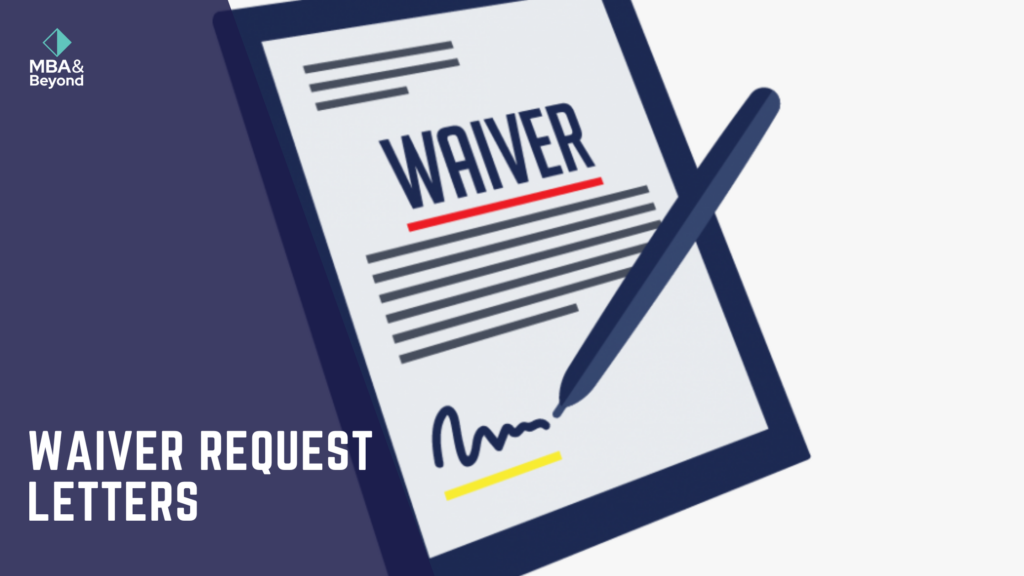
Many consider an MBA to be a golden ticket to getting a dream job with a large-scale income. The MBA programs are becoming popular daily, as an MBA educational program fetches you both knowledge and expertise.
Each and every aspiring candidate dreams of studying in some of the world’s most reputed and famous varsities and colleges. But as you know, in the top B-schools, GMAT scores are considered an application staple, and for some students, one of the most problematic parts of the application process is preparing for standardized tests, either because they don’t have the time to prepare properly or because the said students don’t test well.
This is where the concept of GMAT waiver is introduced. We’ll provide you with each and every detail regarding the GMAT waiver and also give you tips on how to write a successful GMAT waiver request letter.
Quick Snapshot
- What is a GMAT waiver?
- Who should consider applying for a test waiver?
- Major constituents of successful GMAT waiver request letters
- When should I apply for a test waiver?
- Are GMAT scores important?
- How to identify which schools I should apply for with a GMAT waiver?
Top B-schools waiving and its criteria: Basic Criteria for GMAT Waiver
Gmat fee reduction program/ waiver.
- How to write successful GMAT waiver request letters: General tips
- Frequently Asked Questions
*Note: In this article, “GMAT waiver essay” and “GMAT/GRE request letters” are one and the same and used interchangeably. Most schools do not have any essays for GMAT waivers and hence only ask for a letter to request for getting a GMAT waiver.
Talk to Alums of your Target School and know your chances!
Here is the Snapshot of the article:
What is a GMAT Waiver
In a brief manner, one could say that a GMAT waiver allows an MBA program applicant to forgo a test score submission, particularly when one has met certain criteria in terms of work experience, degrees, academic history, or other conditions.
Schools grant GMAT/GRE exemptions at the discretion of admission officers who evaluate each GMAT/GRE waiver request letter/GMAT waiver MBA essay. However, there are some institutions where the waivers are automatically given to those who qualify without a need to draft an additional GMAT/GRE waiver request letter.
Universities such as Syracuse University, UNC (University of North Carolina) & GW (George Washington University) automatically grant GMAT waivers to applicants having more than five years of work experience, whereas NJIT (New Jersey Institute of Technology) exempts GMAT for anyone with an advanced degree.
Who should consider applying for a test waiver
You must be wondering whether or not you should consider submitting GMAT/GRE waiver letter. There are some factors you should keep in mind if you decide to apply. If you are confident enough to demonstrate your abilities via the exam sufficiently and have met the eligibility criteria but struggling to take GMAT/GRE exam, then you might consider drafting GMAT/GRE waiver request letter. We’ll explain in detail what are the constituents of successful GMAT waiver request letters below.
But, if you are able to achieve a higher score than the average of your target program and you meet the eligibility criteria, then ideally, you should not consider a waiver. Because it can prove the strength of your candidacy, so we suggest you go ahead and submit your scores.
Want to pursue an MBA but not sure if your profile fits?
Talk to our Profile Experts to know your chances for a top MBA Program.
However, if you do not have sufficient work experience, leadership skills, academic record, quantitative coursework, or weak application, then applying for a GMAT/GRE waiver is not a strategic decision because the chances of approval of your GMAT/GRE waiver letter are unlikely. As adcoms want students who can handle the school’s challenging academic program and prove to be an asset to their community. So, we advise you to pull up your socks and start preparing early so that you do not regret it at the end of the deadline.
Start your preparation now with us!
Major constituents of successful GMAT Waiver request Letters
When evaluating applicants, adcoms consider career trajectory, success, previous academic performance, and quantitative experience because it is more reliable indicators of ability than any cut-off marks and hence golden answers to how to get GMAT waived.
Schools are putting greater weight on previous courses’ work, work experience, and professional certifications in order to select the most highly qualified applicants from the same limited pool.
See what experts have to say about the impact of your GMAT/GRE letters.
Below Paragraph deals with all the major constituents that are included in successful GMAT waiver request letters.
- Work Experience: Important factor to a good GMAT waiver MBA essay
Work experience incorporates the main reason why B-schools offer test score waivers to applicants. “A real-world experience that an applicant would bring to a program is likely to be more valuable than scoring over a certain number on a test.”
free consultation for Gmat waiver essay and gmat focus edition with top b-school alums
B-schools are aware of the extra work and pressure that entrance exams put on experienced working professionals. For this reason, more and more schools are making the application process less arduous by waiving GMAT requirements. While some B-schools go with the generic meaning, many of the top B-school schools define “relevant work experience” in their own way.
While some consider management responsibilities, Strategic directions, Problem-solving, time management, personal accountability, and decision-making as key factors, many define work experience in a much broader aspect. ‘ The Work experience needs to be of a specific caliber that is relevant to the applicant’s career goals, with the average number of years of work experience required to be more than five years . However, the highest-ranked B- schools exhibit an average to be at least seven years.
Hence, work experience will become an important constituent to creating successful GMAT waiver request letters and a key solution to how to get GMAT waived.
- Academic History & Achievements
Another determinant in assessing successful GMAT waiver request letters is your academic performance. The Academic preferences for each School range from UG academic performance to additional coursework and certifications and even advanced-level degrees. Many of the top B-schools impose a minimum GPA threshold, which ranges from 3.0-3.4 when granting waiver requests.
Learn how important your GPA for Top MBA Programs is.
Universities, such as Pepperdine University, even require that students have degrees in quantitative economics or science, engineering, technology, or mathematics disciplines for evaluating the successful GMAT waiver request letters.
- Professional Certifications- Major requirement to get GMAT waived
Professional certifications such as Certified Public Accountant (CPA), Certified Financial Analyst (CFA), and similar licenses are taken into consideration by many B-schools when awarding waivers.
- Leadership Experience
If your work experience also includes qualities that demonstrate your leadership quality, it will be an advantage for you to put this experience in your GMAT waiver letter because school search for students who can take challenges for themselves, their team, and the community and motivate everyone to be the better version of themselves. We suggest you back up your remarkable efforts by learning how to maximize the strength of your recommendations from senior management and colleagues, who can witness your leadership skills and professional integrity in the face of problems.
Learn how to exhibit leadership experience in your MBA application.
- Problem-Solving Skills
GMAT tests are designed in a way that also showcases problem-solving skills for comprehending problems. The AWA, IR, and especially the quantitative sections analyze the applicants’ performance under specific situations. If you are opting for a GMAT waiver, it would be a great opportunity to showcase your problem-solving skills through your experience in your GMAT waiver letter.
Know the details that your application requires to make a strong impact
When should I apply for a test waiver
There are two types of schools in this case. The first category of school requests you submit your GMAT waiver letter before you submit your application. If your GMAT waiver essay is not granted, then you are supposed to take the exam before completing your application. The second category includes the GMAT waiver request within its application. This means if you applying for a GMAT waiver, then you need to submit your full application before determining whether or not you still need to take the test. We recommend you always read the instructions thoroughly of your chosen school and do your complete research in advance because sometimes the deadline for submitting GMAT waiver requests is just a week ahead.
Book a Profile evaluation with students & alums of top schools! Submit your request and get the MOST Exhaustive and Honest Profile feedback and suggestions from the alumni of your target schools!
Steps to get a MBA without GMAT
Often enough, MBA aspirants are confused about whether or not their profile and other standardized test scores are good enough to cut a GMAT Waiver. Likewise, candidates also fear that a GMAT waiver might hamper their chances of getting into their target school!
1. In such a scenario, we urge MBA aspirants to follow these steps for initiating a GRE/GMAT waiver with any B-school.
- Understand the significance of the GMAT for your TARGET SCHOOLS and look at their criteria to get a GMAT waiver.
- Understand what qualities GMAT reflects in your application and how you can exhibit them with other aspects of your application
- Every school has different criteria for accepting case-by-case waivers; ensure you are well-versed with them!
2. PROFESSIONAL EXPERIENCE
- It should be your biggest strength for applying to MBA programs that don’t require GMAT.
- Professional experience is the best way to exhibit your decision-making, analytical and quantitative skills in a practical example.
- Make a strong case for career progression that reflects your professional growth and stellar leadership examples.
3. Bring DIVERSITY to your application.
For anyone applying with a GMAT waiver for the 2024 intake, diversity is one of the most important aspects of your application!
Highlight the diversity of perception, thought, and perspective, and highlight how differently you’re going to contribute to the MBA communities of your target school to put a strong statement in front of the Adcoms.
4. Draft a unique & Stellar GMAT WAIVER LETTER
- Understand the formatting requirements of the specific program you’re applying to with a GMAT waiver by finding some examples of GMAT waiver letters that others have used successfully.
- Open with a Clear Statement to Highlight the Letter’s Purpose!
- Demonstrate that you have relevant skills to be reflected without appearing for a GMAT through your professional work experience
- Add specific examples to support your claims.
We follow a unique framework to help applicants dig deep into their work experience, leadership potential, strengths, weaknesses, etc., and structure all their essays (including GMAT waivers) in a way that can bring the right impact!
Applying for a MBA without GMAT Based on CFA Program Exemption
If you have a good level of achievement in the CFA Program, for example, having a specific group of the CFA Program(e.g., Level 1, Level 2) or being a charter holder, Congrats! You are eligible for a GMAT/GRE waiver and even might be eligible for an additional course waiver.
Top US MBA programs like Darden, Cornell, Duke, Emory, Dartmouth, John Hopkins, and many more offer exclusive exemptions for candidates who have cleared a specific level of the esteemed CFA exam to acknowledge their achievements by providing course waivers and other benefits! To know more about all the top MBA programs providing a GMAT waiver for MBA 2024 intake based on CFA program exemption, you can refer to our article on “MBA GMAT waiver 2024: CFA Exemptions”.
Applying for an MBA without GMAT as an Army Veteran
Many top B-schools value the leadership and decision-making skills developed during military service and, to honor their duty to the country, provide a GMAT waiver to all eligible candidates with a military background! Moreover, these B- schools offer a waiver for candidates with an army background to realize the value of diversity and thus want to include students from different backgrounds and experiences, making classroom discussions and learning richer in content!
Below are some veteran-friendly programs that value their military experience and support them with a GMAT waiver for their military background. These MBA Programs Without GMAT Requirements are-
Are GMAT Scores Important
GMAT is important in adding more value to your candidacy, but there is an increasing trend within business schools to offer entrance exam waivers and grant admission to students who do not provide GMAT or GRE scores, even at highly ranked programs.
Should applicants meet one or more of the GMAT Waiver eligibility criteria, they will not have to provide their GMAT scores as part of the application process. This approach was incorporated keeping in mind the number of high-potential applicants with many years of work experience held back or even restricting themselves from applying to MBA Programs due to low GMAT Scores.
Among top B-schools, which include the University of North Carolina, the University of Delaware, George Washington University, NJIT, and Syracuse University, most admitted students did not provide GMAT or GRE scores with their applications; only less than three percent of admitted students provided scores.
However, for the Top 25 MBA programs, a good GMAT score is still an important requirement, and if you are submitting a GMAT/GRE waiver request letter (assuming the school is waiving the GMAT requirement and you qualify for it), you must have very strong essays and overall application.
Know how you can make a strong application if you are applying with a GMAT waiver.
How to identify which schools I should apply for with a GMAT waiver
Check with specific institutions for criteria to be eligible for a GMAT waiver. MBA program applicants should determine if they meet eligibility guidelines before submitting a GMAT waiver request letter. Every program determines the eligibility requirements they want to use.
If you qualify for the requirements, you can submit a GMAT waiver request letter.
However, there is one more aspect you should look into. If you are targeting M7 or T10 schools with a waiver, you need to have a strong quantitative background, solid achievements and career trajectory, and a robust narrative to present in your MBA application.
These are some general points you must have before submitting the GMAT waiver request letter:
- Ten years of professional working experience
- Exceptionally high GPA scores and academic records
- An Advanced master’s degree or recognized certification in any other field
- Three recommendation letters
- Transcripts copies of undergraduate and graduate school.
- A formal GMAT waiver request letter meeting all the parameters of the school
The below table enlists the Top notch B-schools providing GMAT waivers for deserving candidates. Carefully go through the eligibility criteria for each of them before applying.
Note – Check B-Schools page for latest eligibility criteria
Top MBA programs offering a GMAT waiver
Some applicants might get confused about both, but these are two different waivers. The GMAT waiver relieves the applicant from taking the GMAT test, and the GMAT fee waiver reduces the costs associated with a GMAT exam. GMAC doesn’t offer applicants GMAT fee waivers directly. They suggest that the schools should give GMAT fee waivers to only those students who are facing financial difficulty. Those business school that sends a request to GMAC gets up to 10 fee waivers in a year. They send a code to the school, and the school uses that code on the basis of the applicant’s needs.
How to write successful GMAT waiver request letters: General tips
- Proper Research. Know all about eligibility criteria and other guidelines. Note that not every school offering a GMAT waiver will have the same criteria.
- Stay focused and discuss specific aspects that demonstrate quantitative and analytical skills to successfully process and evaluate information.
- Clear & Concise style of Writing.
- Rather than exaggerating, target two or three most important skills and focus majorly on those.
- Revising & Proofreading
How to ask for a GMAT waiver/How to write a GMAT waiver essay- GMAT/GRE waiver request letters sample
University name:-
University Address:-
Salutation- Sir or Madam
1st Paragraph: About Yourself
Introduce yourself and give an overview of the particular criteria that qualified you to submit the GMAT/GRE waiver request letter in a brief manner. Write about why you are writing & what your request is.
2nd Paragraph
Elaborate on your academic and professional achievements but don’t exaggerate. Overstating your qualifications can come off as bragging; no matter how great an accomplishment was, if it doesn’t contribute to your purpose of convincing admissions, it shouldn’t be included.
3rd Paragraph
Provide valid certificates & awards as evidence. Point out the things you have done that match their requirements to help you get GMAT waived. Make sure to discuss specific aspects of any professional work experience that match up with the skills the GMAT is meant to demonstrate, which can help you back up your argument for applying for a waiver.
4th Paragraph:
Ending statement. Thank the reader for taking the time to read your letter. Make it as well polished as you can.
Contact details.
This is it from our side; we know it’s quite long. But we hope you got some great insights about the GMAT waiver request letter. If you require an expert to give your application or essay the light that can shine in the eyes of adcoms, you can count on us.
We offer a limited number of complimentary profile evaluations each week to maximize your chances. We match you with the students and alums of top B-Schools according to your background and target schools. In this call, the experts will try to dig out your USP for top B-schools and provide you with honest feedback on your profile and chances to your target schools.
Schedule a free profile evaluation
OUR PROCESS
Frequently Asked Questions:
- 1. How do I get a GMAT Waiver? You need to have strong elements on your profile like work experience, academics, professional certifications, etc. Also, you need to see the criteria for your target schools and see if you meet the requirements. If yes, you can go ahead and submit a GMAT waiver request letter (if required).
- 2. Which business schools are waiving the GMAT? You can see the list of business schools waiving GMAT in 2021-22 and their criteria in the table above.
- 3. Is GMAT waived for 2022? Yes, many schools are waiving the GMAT for 2022 intake. Some top schools include MIT, Ross, Kelley and Darden.
- 4. What is an acceptable GMAT score? For all the schools, there is generally no minimum limit or “acceptable GMAT score” as such. However, you may look into the class profile of your target schools to know what can be a good GMAT score to target. If you are an over-represented applicant (like Indian or Chinese), you may want to add 20+ in the average range to target a good GMAT for yourself.
If you need more in-depth information about any particular aspect of the application, process, interviews, and course structure, feel free to hop on a 1:1 call with our team of experts .
Leave a Reply
Your email address will not be published. Required fields are marked *
Articles You Might Like

Should an International Candidate go for an INSEAD R3 MBA?

Top MBA programs starting in January 2025
Upcoming Events
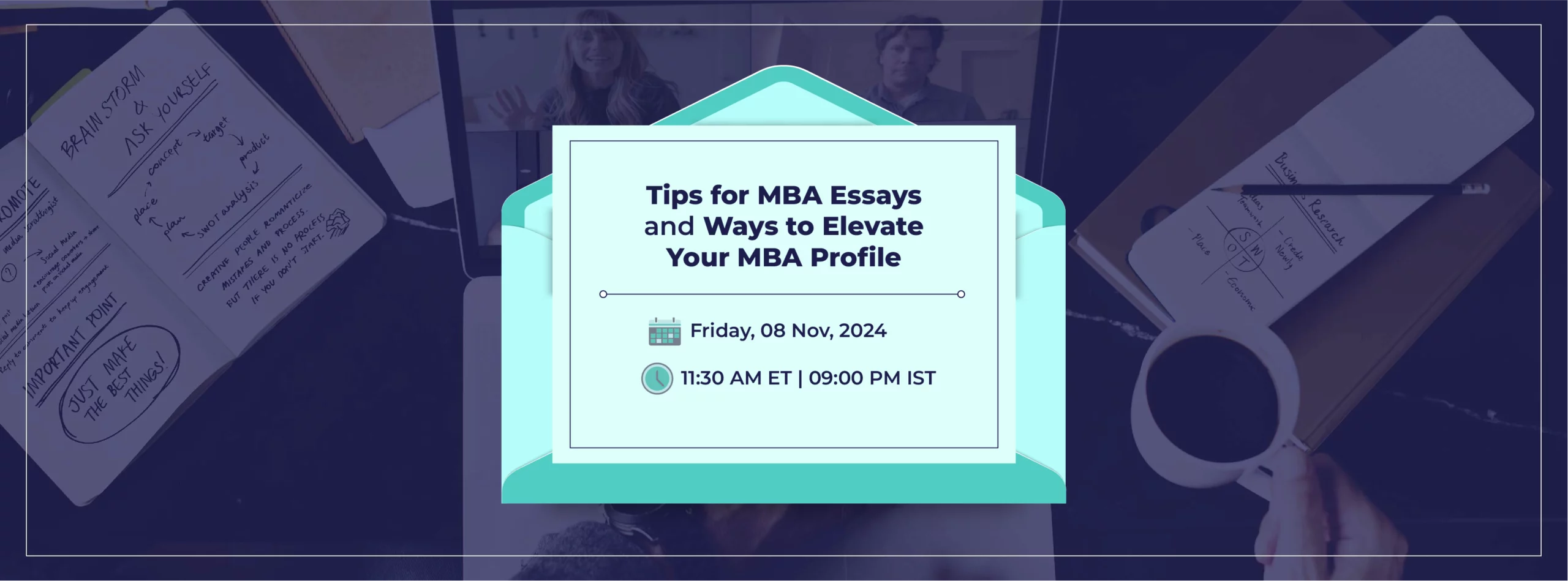
Tips for MBA Essays and Ways to Elevate Your MBA Profile
November 8, 2024 | 9:00 pm – 10:00 pm
UPCOMING EVENT: Tips for MBA Essays and Ways to Elevate Your MBA Profile. Register now
Opinion The hard truth: Americans don’t trust the news media
A note from our owner..
Jeff Bezos is the owner of The Washington Post.
In the annual public surveys about trust and reputation, journalists and the media have regularly fallen near the very bottom, often just above Congress. But in this year’s Gallup poll , we have managed to fall below Congress. Our profession is now the least trusted of all. Something we are doing is clearly not working.
Let me give an analogy. Voting machines must meet two requirements. They must count the vote accurately, and people must believe they count the vote accurately. The second requirement is distinct from and just as important as the first.
Likewise with newspapers. We must be accurate, and we must be believed to be accurate. It’s a bitter pill to swallow, but we are failing on the second requirement. Most people believe the media is biased. Anyone who doesn’t see this is paying scant attention to reality, and those who fight reality lose. Reality is an undefeated champion. It would be easy to blame others for our long and continuing fall in credibility (and, therefore, decline in impact), but a victim mentality will not help. Complaining is not a strategy. We must work harder to control what we can control to increase our credibility.
Presidential endorsements do nothing to tip the scales of an election. No undecided voters in Pennsylvania are going to say, “I’m going with Newspaper A’s endorsement.” None. What presidential endorsements actually do is create a perception of bias. A perception of non-independence. Ending them is a principled decision, and it’s the right one. Eugene Meyer, publisher of The Washington Post from 1933 to 1946, thought the same, and he was right. By itself, declining to endorse presidential candidates is not enough to move us very far up the trust scale, but it’s a meaningful step in the right direction. I wish we had made the change earlier than we did, in a moment further from the election and the emotions around it. That was inadequate planning, and not some intentional strategy.
I would also like to be clear that no quid pro quo of any kind is at work here. Neither campaign nor candidate was consulted or informed at any level or in any way about this decision. It was made entirely internally. Dave Limp, the chief executive of one of my companies, Blue Origin, met with former president Donald Trump on the day of our announcement. I sighed when I found out, because I knew it would provide ammunition to those who would like to frame this as anything other than a principled decision. But the fact is, I didn’t know about the meeting beforehand. Even Limp didn’t know about it in advance; the meeting was scheduled quickly that morning. There is no connection between it and our decision on presidential endorsements, and any suggestion otherwise is false.
When it comes to the appearance of conflict, I am not an ideal owner of The Post. Every day, somewhere, some Amazon executive or Blue Origin executive or someone from the other philanthropies and companies I own or invest in is meeting with government officials. I once wrote that The Post is a “complexifier” for me. It is, but it turns out I’m also a complexifier for The Post.
You can see my wealth and business interests as a bulwark against intimidation, or you can see them as a web of conflicting interests. Only my own principles can tip the balance from one to the other. I assure you that my views here are, in fact, principled, and I believe my track record as owner of The Post since 2013 backs this up. You are of course free to make your own determination, but I challenge you to find one instance in those 11 years where I have prevailed upon anyone at The Post in favor of my own interests. It hasn’t happened.
Lack of credibility isn’t unique to The Post. Our brethren newspapers have the same issue. And it’s a problem not only for media, but also for the nation. Many people are turning to off-the-cuff podcasts, inaccurate social media posts and other unverified news sources, which can quickly spread misinformation and deepen divisions. The Washington Post and the New York Times win prizes, but increasingly we talk only to a certain elite. More and more, we talk to ourselves. (It wasn’t always this way — in the 1990s we achieved 80 percent household penetration in the D.C. metro area.)
While I do not and will not push my personal interest, I will also not allow this paper to stay on autopilot and fade into irrelevance — overtaken by unresearched podcasts and social media barbs — not without a fight. It’s too important. The stakes are too high. Now more than ever the world needs a credible, trusted, independent voice, and where better for that voice to originate than the capital city of the most important country in the world? To win this fight, we will have to exercise new muscles. Some changes will be a return to the past, and some will be new inventions. Criticism will be part and parcel of anything new, of course. This is the way of the world. None of this will be easy, but it will be worth it. I am so grateful to be part of this endeavor. Many of the finest journalists you’ll find anywhere work at The Washington Post, and they work painstakingly every day to get to the truth. They deserve to be believed.
About guest opinion submissions
The Washington Post accepts opinion articles on any topic. We welcome submissions on local, national and international issues. We publish work that varies in length and format, including multimedia. Submit a guest opinion or read our guide to writing an opinion article .
Post Opinions also thrives on lively dialogue. If you have thoughts about this article, or about anything The Post publishes, please submit a letter to the editor .


IMAGES
VIDEO
COMMENTS
In essay letter writing, the writer has the freedom to share their ideas and experiences in a unique and creative way, while also adhering to the basic principles of essay writing, such as structure, coherence, and logical argumentation. This Essay Letter Writing is an effective way to communicate complex ideas in a clear and engaging manner.
The basic steps for how to write an essay are: Generate ideas and pick a type of essay to write. Outline your essay paragraph by paragraph. Write a rough first draft without worrying about details like word choice or grammar. Edit your rough draft, and revise and fix the details. Review your essay for typos, mistakes, and any other problems.
In the case of a group project, list all names of the contributors, giving each name its own line in the header, followed by the remaining MLA header requirements as described below. Format the remainder of the page as requested by the instructor. In the upper left-hand corner of the first page, list your name, your instructor's name, the ...
Step 1: Write the contact information and date. All formal letters start with the contact information and date. In the full block style, this goes in the upper left-hand corner. First, as the sender, type your full name and address aligned to the left side, just as you would when addressing an envelope.
Date: When you write a formal letter, it's crucial to include the date on which you wrote it. This information is essential for time-sensitive communication. Address: Write the recipient's full address, including their PO Box number or office suite. Return address: Include your company's full address.
Key Takeaways. A successful essay involves preparation, writing, and revisions with a clear understanding of your message and audience. The introduction should hook the reader, present the thesis statement, and give an outline of the essay's main points. Effective body paragraphs focus on a single idea, using evidence and analysis to support ...
Come up with a thesis. Create an essay outline. Write the introduction. Write the main body, organized into paragraphs. Write the conclusion. Evaluate the overall organization. Revise the content of each paragraph. Proofread your essay or use a Grammar Checker for language errors. Use a plagiarism checker.
Harvard College Writing Center 5 Asking Analytical Questions When you write an essay for a course you are taking, you are being asked not only to create a product (the essay) but, more importantly, to go through a process of thinking more deeply about a question or problem related to the course. By writing about a
This essay begins by discussing the situation of blind people in nineteenth-century Europe. It then describes the invention of Braille and the gradual process of its acceptance within blind education. Subsequently, it explores the wide-ranging effects of this invention on blind people's social and cultural lives.
Step 2: Pick one of the things you wrote down, flip your paper over, and write it at the top of your paper, like this: This is your thread, or a potential thread. Step 3: Underneath what you wrote down, name 5-6 values you could connect to this. These will serve as the beads of your essay.
March 16, 2001. Dear Mr. English: The first paragraph of a typical business letter is used to state the main point of the letter. Begin with a friendly opening, then quickly transition into the purpose of your letter. Use a couple of sentences to explain the purpose, but do not go in to detail until the next paragraph.
Table of contents. Step 1: Hook your reader. Step 2: Give background information. Step 3: Present your thesis statement. Step 4: Map your essay's structure. Step 5: Check and revise. More examples of essay introductions. Other interesting articles. Frequently asked questions about the essay introduction.
Here are the eight steps to write an essay: Stage 1: Planning. 1. Pick an appropriate research topic. In certain cases, your teacher or professor may assign you a topic. However, in many cases, students have the freedom to select a topic of their choice.
12. End with a positive note. If you wish to explicitly demonstrate your positive values, do not hesitate to write a short piece of pleasantry toward the end of your cover letter. Again, it is needless to say that you have to maintain a formal yet non-pretentious tone in writing this part of your letter.
Each paragraph should make a single specific point. Use an appropriate formal tone and register in the wording of the letter. Avoid contractions, slang, and abbreviations. The concluding 'action point' paragraph states what you want the recipient to do. The formal ending, such as Yours Sincerely or Yours Faithfully.
Strategies for Essay Writing--Complete. description. Tips for Reading an Assignment Prompt. description. Asking Analytical Questions. description. Thesis. description. Introductions. description. What Do Introductions Across the Disciplines Have in Common? description. Anatomy Of a Body Paragraph. description. Transitions.
Basic essay structure: the 3 main parts of an essay. Almost every single essay that's ever been written follows the same basic structure: Introduction. Body paragraphs. Conclusion. This structure has stood the test of time for one simple reason: It works. It clearly presents the writer's position, supports that position with relevant ...
Paragraph #2: an essay overview + the essence of the essay. Paragraph #3: repeated interest in the admission. Best regards + your name. Try to follow those simple steps, as they will boost the readability of your document: Pick a modern template for a cover letter. Stick to the right length of a cover letter.
Example cover letter for an essay Here is an example of what a quality essay cover letter might look like: Lili Eaglestone 123 Luna Lane Los Angeles, CA December 18, 2022 Dear Admissions Committee, My name is Lili Eaglestone, and I am applying to become a student at the University of Southern California for fall 2023. Writing my application essay was a delight, as I am very passionate about ...
Follow these tips to write an impactful essay that can work in your favor. 1. Start Early. Few people write well under pressure. Try to complete your first draft a few weeks before you have to turn it in. Many advisers recommend starting as early as the summer before your senior year in high school.
The basic structure of an essay always consists of an introduction, a body, and a conclusion. But for many students, the most difficult part of structuring an essay is deciding how to organize information within the body. This article provides useful templates and tips to help you outline your essay, make decisions about your structure, and ...
On the final line, write the city, state, and ZIP code. For domestic mail, use the two-letter state abbreviation. Example: "San Francisco, CA 94122". If sending internationally, add the country name on a new line. Example: "Canada" or "United Kingdom". Let's have a look at two different examples to address a letter:
Choose a simple yet professional format. The standard format includes the sender's contact information at the top, followed by the recipient's contact information. It is ideal to keep the typography clean and legible. Adopt an appropriate tone. For most business letters, a formal but courteous tone is best.
You need to have strong elements on your profile like work experience, academics, professional certifications, etc. Also, you need to see the criteria for your target schools and see if you meet the requirements. If yes, you can go ahead and submit a GMAT waiver request letter (if required). 2.
For most of my career, I taught writing, literature, and language, primarily to university students. I quit, in large part, because of large language models (LLMs) like ChatGPT. Virtually all ...
Every good introduction needs a thesis statement, a sentence that plainly and concisely explains the main topic. Thesis statements are often just a brief summary of your entire paper, including your argument or point of view for personal essays. For example, if your paper is about whether viewing violent cartoons impacts real-life violence ...
Submit a guest opinion or read our guide to writing an opinion article. ... or about anything The Post publishes, please submit a letter to the editor. Share. Comments. Popular opinions articles ...